
Home » Travel Guides » Italy » 15 Best Things to Do in Palermo (Italy)

15 Best Things to Do in Palermo (Italy)
Palermo is the capital of Sicily which is the largest island in the Mediterranean sea and sits at the bottom of Italy in close proximity to Tunisia and Malta. With a population of 676,000 and a greater metropolitan population of 1.3 million, it serves as the islands cultural and economical centre. Cave drawings have been found in Palermo and human settlements have been dated as early as 8000 BC. Initially under Roman Control, once the empire started to collapse, Palermo came under Germanic control and then subsequently Arabic rule and finally Christian conquers in the 1000’s.
Today, Palermo is a thriving city that has seen huge development since the 1980’s and its economy centres around tourism and services. As a tourist destination, Palermo offers a huge range of historical attractions, ancient buildings, and dramatic coastlines to explore.
Lets explore the best things to do in Palermo :
1. Palermo Cathedral

Due to the various conquering nations and empires that have had a presence in Palermo, this cathedral has a myriad of different styles and is a truly fascinating building.
Originally constructed in 1185 on the instruction of Pope Gregory I, the church has seen many uses including a mosque and a crypt.
The Moorish influence is present on the exterior and it features a fine central basilica and a tall renaissance clock tower.
Furthermore the portico side entrance features several ornate columns and a triangular pediment with a detailed fresco.
Inside, a prominent feature is the treasure chamber that holds various artefacts from different time periods of the church, and also the tomb of Emperor Frederick II.
2. Capella Palatina

The Palatine Chapel is located in close proximity to the Pallazzo dei Normanni in the centre of Palermo and is one of the best preserved examples of Byzantine architecture and artwork in Europe.
As part of the palace, it was built in 1132 and commissioned by Roger II of Sicily.
Dedicated to Saint Peter, the chapel has a central basilica and features a plethora of fantastic Byzantine artwork and architecture.
Covered in stunning mosaics that exhibit a fantastic amount of detail and colour, the walls and ceiling are packed full of religious and historical iconography.
Every angle or corner you turn you will find another piece of detail or interesting depiction – This really is a true feat of ingenuity and artistic creation.
3. Palazzo dei Normanni

The Royal Palace or the Palace of the Normans served as the main seat of the Kings of Sicily.
It stands as one of the oldest royal palaces in Europe and was originally created in the 9th century by the Emir of Palermo.
The Norman and Moorish influence is undeniable and the palace exudes an official and stately feel.
A main feature of the exterior is the central courtyard that features some beautiful stone arches and decoration.
Furthermore, the Capella Palatina is a connecting building that has some beautiful mosaics and artwork dating back hundreds of years.
Ensure you visit this royal residence for a true slice of Sicilian history.
4. Palermo Archaeological Museum

Located in close proximity to the Teatro Massimo, the Palermo Archaeological Museum is a fantastic place to visit for those who love history.
This museum contains a vast collection of ancient Greek art and various artefacts and findings from the region and island of Sicily.
Split into various different sections, the museum is easy to navigate – Exhibits include underwater artefacts, Phoenician artefacts, Roman artefacts and more.
Notable items include the Palermo Stone that contains a list of Egyptian rules, the marble statue of Satyr, lion statues from the ancient site of Selinunte and a selection of decorated Greek ceramics.
5. La Martorana

Palermo is packed full of ancient and beautiful religious buildings and the Martorana (Cathedral of St. Mary of the Admiral) is a truly delightful example.
As with Palermo Cathedral, La Martorana also features an amalgamation of various architectural styles due to years of conquest.
Located in the Piazza Bellini, the church is next to the famous Pretoria Fountain and Quattro Canti square.
Inside this fabulous building, the design and artwork is again sublime – The main dome features a golden mosaic of Christ and the ceilings and arches are full of frescos and colourful depictions.
It truly is a fantastic building to behold and the ornate workings will leave you in disbelief.
6. Capuchin Abbey and Catacombs

The order of Capuchin Friars dates back to the 1500’s and this abbey was dedicated to their usage.
Whilst the abbey itself is not a fantastic building, the catacombs are the true marvel and are not like any other attraction in Europe.
Here you will travel underground into the vast catacombs and see a macabre variety of burials and well preserved bodies from various periods in time.
The Capuchin Monks would preserve the bodies and keep them in their original garments and also use embalming techniques.
Tours are now possible of the catacombs and you can see this bizarre burial ground containing over 8000 bodies.
Suggested tour : Capuchin Catacombs of Palermo & Monreale Cathedral Tour
7. San Giovanni degli Eremiti

A truly small and charming church, this building dates back to the 6th century and is remarkably well preserved despite its immense age.
Domed towers sit at one end of the church and feature a brilliant red colouration that is still extremely vibrant.
The architectural style is considered to be a combination of Arabic and Norman but has later Roman additions.
A pleasant garden lies at the back of the church filled with exotic plant life and trees.
As one of the most important Arab-Norman buildings in Palermo, the inside remains quite simple with only a few frescos and religious artwork.
8. Monte Pellegrino

Sicily is full of mountains and hilly regions and Monte Pellegrino sits next to Palermo and offers an escape to nature with unparalleled views of the city and Mediterranean.
Aside from being a fantastic tourist attraction, the locals love to come here for an afternoon of fun too so expect to do some mingling.
Only 9 miles from the city centre, this mountain is easily accessible and there is a regular bus service that runs to the top from Politeama.
If you are particularly adventurous and fit, it is possible to hike to the top of Mount Pellegrino to, but don’t undertake this venture unless you are sure of your physical fitness and survivability!
9. Palermo Food Markets

Food markets are a fantastic way to sample local life and so see the heart of a city.
Palermo has several wonderful food markets that operate daily.
The main food markets include Ballaro, Cap and Vucciria all of which are located in the centre of the city and not far from the main attractions.
Here you will find street vendors and shop fronts full of delicious fresh fruits, vegetables, cakes, pastries and more.
Prepare to have your sense assaulted with the variety of smells and the noise from the vendors selling their wares.
A truly fascinating part of Palermo that should not be missed – Also consider a specialized street food tour that will guide you through the best spots.
10. Teatro Massimo

Who would have thought that a theatre would be one of the largest structures in Palermo? The Teattro Massimo is immense and it towers over the relatively small buildings surrounding the Piazza Giuseppe Verdi.
Opened in 1897, it is the largest Opera House in Italy and is famed for its acoustic qualities.
With an exterior that looks more like a palace, this building is truly opulent, but the interior is just as lavish.
Guided tours are available daily of the interior of this fantastic building including tours of the actual auditorium and its boxes.
For film buffs, this theatre is also the place that the final scenes of the Third Godfather movie were filmed!
11. Fontana Pretoria

A monumental fountain that lies in the centre of the Piazza Pretoria, the Fontana Pretoria was built by a Florentine architect in 1554 and transferred to Palermo in 1574. Depicted on the fountain are marble statues of the twelve Olympians from ancient Greek Mythology including Zeus, Poseidon, Apollo and Ares.
Each statue is highly decorated and sculpted and frames the centrepiece perfectly.
Aside from the mighty Olympians, the other statues represent the animals and rivers of Palermo.
12. Ustica Island

Ustica is a tiny island that lies in the Tyrrhenian Sea and is roughly 50km from the coast of Sicily and Palermo.
Excavations have dated settlements here for hundreds of years and the current population is just over 1300. Ferries leave for Ustica from Palermo Harbour and it offers truly remarkable day trip.
Here you will find a gorgeous rocky island landscape that retains its charm and history.
Explore the cliffs and climb to see the tower of Spalmatore, or even partake in a spot of Scuba Diving which Ustica is well-known for due to the deep waters surrounding the base of the island.
13. Mondello Beach

15 minutes to the north of Palermo lies the buzzing town of Mondello – Here you will find the sublime Mondello Beach that is a great place to relax and enjoy the cool Mediterranean waters.
Although crowded at peak times, you will still have ample space to sunbathe or build a sandcastle! At the centre of the beach is the immense Art Nouveau pier and building that contain a restaurant and bar.
Come to Mondello to escape from sight-seeing and indulge in some relaxation or swimming in the crystal clear waters of the bay.
14. Quattro Canti

A simple yet effective and beautiful attraction, the Quattro Canti is an open square located in the centre of Palermo.
Constructed in 1608, the square provides a crossroads for Via Maqueda and VIa Vittorio Emannuel but it is the architecture that makes it famous.
At each corner of the square lies a semi circular face that contains marble columns, inscriptions and statues of important Italian citizens and rulers.
Their symmetry and design are fantastic and you feel as if you have stepped into Florence or Renaissance Italy.
15. Try your hand at Parasailing

If you are looking for some adventure and adrenaline fuelled activities, why not try your hand at parasailing? Palermo lends itself to this sport due to its calm waters and location in the Mediterranean sea.
At the harbour and the beaches you can easily find tour providers offering this activity and prices are usually reasonable.
Glide over the city and waters in style and see Sicily unfold beneath your eyes – This is truly a memorable experience that you will treasure forever!
15 Best Things to Do in Palermo (Italy):
- Palermo Cathedral
- Capella Palatina
- Palazzo dei Normanni
- Palermo Archaeological Museum
- La Martorana
- Capuchin Abbey and Catacombs
- San Giovanni degli Eremiti
- Monte Pellegrino
- Palermo Food Markets
- Teatro Massimo
- Fontana Pretoria
- Ustica Island
- Mondello Beach
- Quattro Canti
- Try your hand at Parasailing

16 Top-Rated Tourist Attractions in Palermo
Written by Barbara Radcliffe Rogers Updated Dec 25, 2023 We may earn a commission from affiliate links ( )
Palermo's oldest area borders Via Vittorio Emanuele, between the Norman palace and the cathedral, its two biggest tourist attractions. The city expanded to the harbor under the Arabs in the 9th to 11th centuries as capital of the Emirs of Sicily, a city of mosques and palaces equal to those in Baghdad and Cordoba.
The Normans captured the city in 1072, and in 1282, in the rebellion known as the "Sicilian Vespers," all the French were murdered or expelled by the House of Aragon, whose Spanish viceroys enlarged Palermo, laying out Via Maqueda and the Quattro Canti. You'll find places to visit in Palermo reflecting all three of these periods of occupation.
After Sicily became an autonomous region in 1946, Palermo's harbor was enlarged and its industry expanded, but Palermo remains the poorest of Italy's provincial capitals.
No trip to Palermo is complete without a visit to the magnificent Monreal Cathedral complex, the royal pantheon built by the Norman King William II, which survives today almost exactly as it was when built in the 1100s. Monreal is only 10 kilometers from the city and easy to reach by bus.
For ideas on the best things to see and do, refer to our list of the top tourist attractions in Palermo.
See also: Where to Stay in Palermo
1. Cattedrale (Cathedral)
2. palazzo dei normanni (norman palace), 3. cappella palatina, 4. la martorana, 5. antonino salinas regional archeological museum, 6. catacombe dei cappuccini (capuchin catacombs), 7. see a performance or go backstage at teatro massimo, 8. palazzo abatellis and galleria regionale della sicilia, 9. quattro canti, 10. san giovanni degli eremiti, 11. san cataldo, 12. santa maria di gesù, 13. santo spirito (chiesa del vespro), 14. palazzo chiaramonte, 15. foro umberto i and the botanic garden, 16. sample traditional sicilian cuisine, where to stay in palermo for sightseeing, palermo - climate chart.
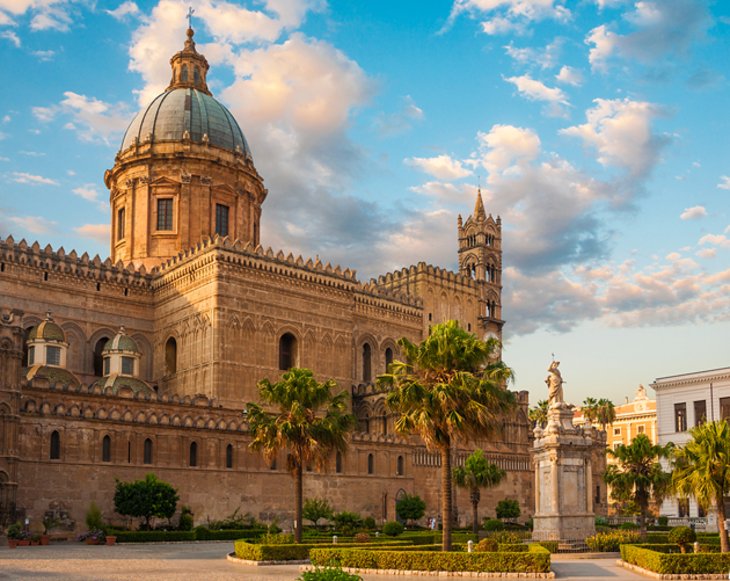
The east exterior of Palermo's cathedral retains the original Norman character: three apses, cross-over round arches, and curved parapets. The south side, overlooking the square, is memorable for its 1453 Gothic-Catalan portico through which you'll enter. One of its columns, with an early Arabic inscription, comes from a mosque.
The triangular pediment contains a carving, God the Father on His Throne , and above the doorway, a 13th-century mosaic of the Virgin Mary on a gold background. The bell-tower dates to the 12th century but was rebuilt in 1840. The Loggia dell'Incoronata to the left of the west front, where kings appeared following their coronation, was also built in the 12th century but altered in the 15th.
You enter into the right aisle, where the first two chapels contain the monumental tombs of the Norman-Hohenstaufen dynasty. The four sarcophagi are in purple Egyptian porphyry, previously permitted only for the tombs of Roman and Byzantine emperors.
At the left front is that of Frederick II, supported by four lions; the tympanum shows the Norman crown, and on the top are decorative panels of the Virgin Mary and Christ between symbols of the Apostles. You'll see copies of this in tombs of Sicilian nobility elsewhere on the island.
In a figural sarcophagus in the wall on the right is the tomb of Frederick's first wife, Constance of Aragon, who died in 1222. The sarcophagus was opened in 1781, and inside, grave objects were found that you can see in the cathedral treasury. The most outstanding of these is the almost priceless crown of Constance of Aragon, richly decorated with strings of pearls and precious stones. It is probably the same one with which Frederick II was crowned emperor by Pope Honorius III in 1220-he would have placed it in Constance's grave.
Address: Piazza della Cattedrale, Palermo
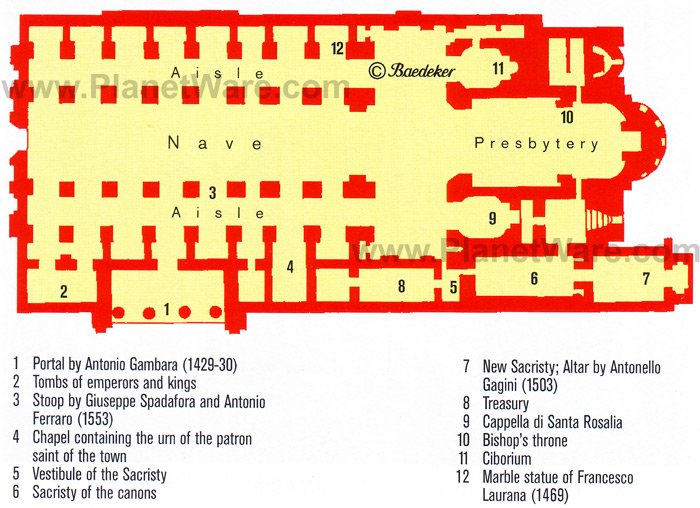
In the 9th century, the Arabs built a palace for their Emir, and under the Norman rulers and the Hohenstaufen Frederick II, the palace became even more splendid. It suffered a long period of neglect, until the Spanish viceroy renovated and extended it to use as his residence. Since 1947, the regional parliament of Sicily has sat here.
One prominent Norman structure remains on the northeast front, the high Torre Pisana with its neat square stone blocks and blind arcades of ogival arches. It is the last remaining of the original four towers; inside is a typical square hall, above which an observatory was built in 1791.
You enter into the Cortile Maqueda, a square courtyard that was constructed in 1600 surrounded by three stories of arcades with rounded arches. Steps lead to the core of the palace, the Cappella Palatina on the first floor and the Appartamenti Reali (Royal Apartments) on the second. Here, you'll see the Sala di Ercole (Hall of Hercules), where the Sicilian Parliament now sits, just as the Barons' Parliament did in the Middle Ages.
The Sala di Ruggiero is completely covered with mosaics showing hunting and animal scenes. To the west of the palace stands the Porta Nuova , the magnificent gateway built in 1535.
Address: Via Vittorio Emanuele, Palermo
This court church of the Normans was consecrated in 1140; the mosaics in the chancel were probably completed in 1143, and those in the nave somewhat later. Around 1350, the mosaic on the west wall portraying Christ between Peter and Paul was added.
In spite of all the changes through the centuries, the interior has not lost the overall harmony between the Latin basilica, the Byzantine dome and mosaic decoration, and the Arabic stalactite ceiling. There is a mystical semi-darkness in this triple-aisled basilica, pierced only by a shimmer of gold. The wooden ceiling of the central aisle is decorated in the Arabic style, with stalactites painted with small scenes.
Notice at the western end, to the left of the entrance, an example of the Normans' reverence for royalty: the raised marble platform for the royal throne. The pulpit stands on carved pillars decorated with inlay work, and the lecterns are carved with the symbols of the Apostles Mark and John. A tall paschal candelabra is decorated in reliefs of flowers and figures, the center one showing Christ with King Roger II, the chapel's founder, kneeling before him.
But it is the mosaics covering all the internal walls for which the chapel is most famous. Those in the nave reflect Old Testament themes in the central aisle and New Testament themes in the side aisles, beginning with the story of the Creation on the top of the south wall of the central aisle and continuing clockwise to the top of the north wall, where you'll see scenes from the Fall of Man to the building of Noah's Ark.
The stories continue along the bottom of the south wall. In the side-aisles are scenes of Paul and Peter. While the mosaics in the nave tell a continuing story, those in the dome of the sanctuary center on Christ. These mosaics are 18th-century-the difference in style and quality between these and those of the 12th century is striking.
Address: Palazzo dei Normanni, Palermo
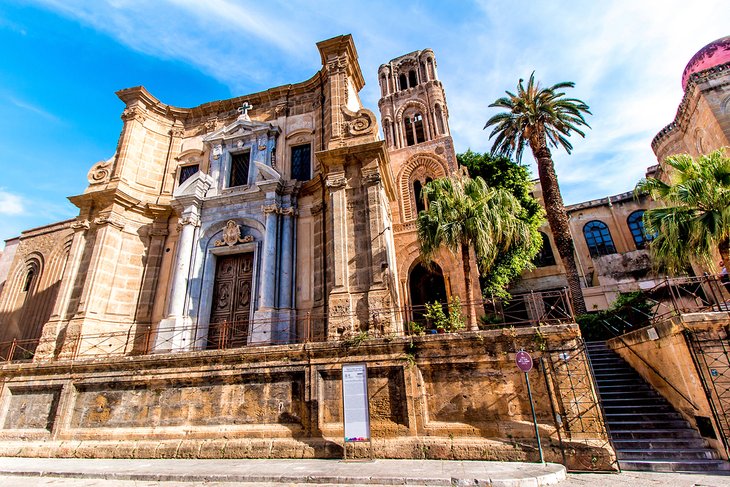
The church of Santa Maria dell'Ammiraglio, more commonly called La Martorana, is best known for its beautiful 12th-century mosaics. The Baroque front, added along with the bell tower after an earthquake in the 1720s, blocks the view of this Arabic-influenced church, but its basic architectural concept is Byzantine.
It was designed as a domed church with four arms of equal length and a chancel with three apses, the dominant style since mid-Byzantine times. But it has undergone considerable changes. In 1200, a narthex, vestibule, and bell-tower were added on the west side.
In 1435, King Alfonso of Aragon gave the church to the Benedictine nuns, and in the 17th century, the narthex and the open atrium were included in the main structure, accounting for its present irregular shape. Between 1683 and 1686 the central apse, together with its mosaics, was pulled down and replaced by a larger rectangular room. The nuns also had frescoes painted on the walls.
But through all this, the most valuable part has been preserved, the mosaics on a gold ground, the oldest of its kind in Sicily, from about 1150. The focal point is Christ the Pantocrator in the center with the Greek inscription, "I am the light of the world." He is surrounded by four angels and in the drum of the dome are prophets with the Apostles in the four corners.
The Triumphal Arch portrays the Annunciation, while in the side apses are Mary's parents; the birth of Christ and the death of Mary are pictured in the barrel vaulting. Two mosaics in the anteroom of the narthex show the founder and patron of the church, George of Antioquia, and Christ crowning King Roger II-a demonstration of the demands made by the Norman kings against Byzantium and against the Pope.
Address: Piazza Bellini, Palermo
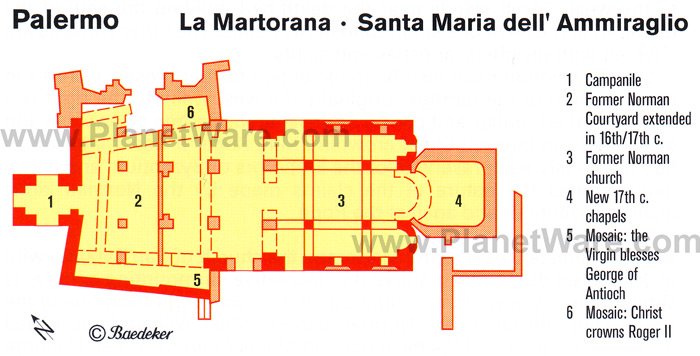
The incredible collection of antiquities in Palermo's Antonino Salinas Regional Archeological Museum (Museo Archeologico Regionale Antonino Salinas) is one of the finest in Italy and includes some world-famous finds. Even a list of the most outstanding highlights is long. Off the small 17th-century cloister are Egyptian and Phoenician items, including the Palermo Stone, the hieroglyphic inscription on which includes a list of Egyptian Pharaohs of the Ancient Empire (3238-2990 BC), and in the Great Cloister is a colossal second-century BC statue of Zeus.
Also on the ground floor are terra-cotta decoration from Temple C at Selinunte, and the unquestionably most important room, displaying primitive and classical sculptures from the temples at Selinunte.
The oldest pieces in the Selinunte Room are on the right: the four Salinas metopes (frieze panels) from about 575 BC, showing the Gods of Delphi (Artemis, Leto, Apollo), a sphinx, the Abduction of Europa , and Hercules and the Bull . On the left wall are three metopes portraying Apollo's four-horse chariot, Perseus slaying the Medusa, and Hercules and the Kerkopes .
The rear wall includes a reconstruction of parts of the Pronaos Frieze, an example of Selinunte art at its very best (470-460 BC), and in the center stands the bronze Ephebe of Selinunte , from about 470 BC. The most important Etruscan pieces from Chiusi are the gravestones with banqueting scenes and death-dances (530-480 BC) and a sixth-century BC statue of the god Canopus.
On the next floor, the pottery department contains terra-cotta votive statuettes from Selinunte, and bronzes of Etruscan, Greek, and Roman civilizations. Notice especially the Etruscan mirrors and the large Mercury staff. Here, too, are Greek marble sculptures with Attic grave-reliefs. Roman sculpture includes some major portraits, and there is a Late Roman mosaic from Lilybaeum showing the Four Seasons.
If you still have energy enough left for the third floor, you'll see prehistoric stone objects from the caves at Lévanzo and Addaura; Late Stone Age vessels from the Stentinello civilization; pieces from the Copper Age in western Sicily; and Greek ceramics including vases of Corinthian, Ionic, Spartan, Attic, Etruscan, and Italic origin. Wall decorations from a house in Solunto are worth seeing, as are floor-mosaics from Palermo and elsewhere.
Address: Via Bara all'Olivella 24, Palermo
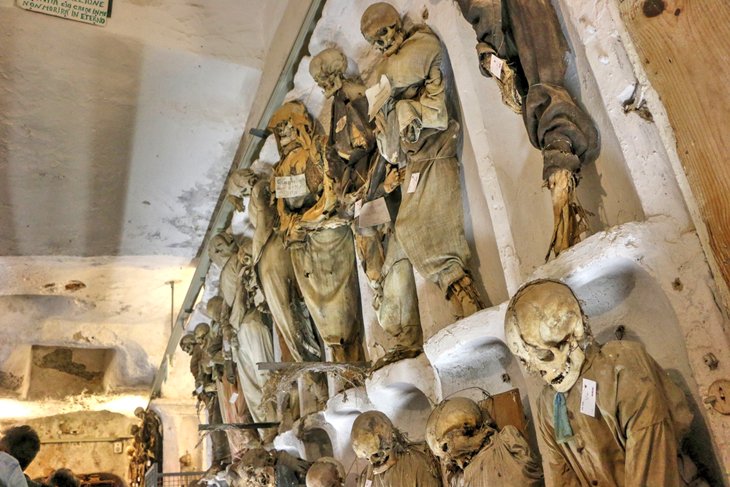
By far Palermo's most bizarre attraction, but one of its most popular, is the Capuchin Abbey, known for its Catacombs. These underground passages were hewn in the volcanic rock after 1599 and used as burial places right up to 1881. Inside, you'll be greeted by the macabre scene of about 8,000 mummified corpses, arranged by sex and status, lying in the passageways or hanging from the walls.
The clothes they wear may look newer, as until a few years ago the mummies were given regular changes of fresh clothes by their relatives. The bodies were first laid in the colatoio , a small, tightly closed drying-room, and after eight months, they were washed in vinegar, dressed, and placed in the niches in the walls or in open coffins.
Don't plan on taking pictures to amaze your friends, as photography is strictly prohibited inside.
Address: Piazza Cappuccini 1, Palermo
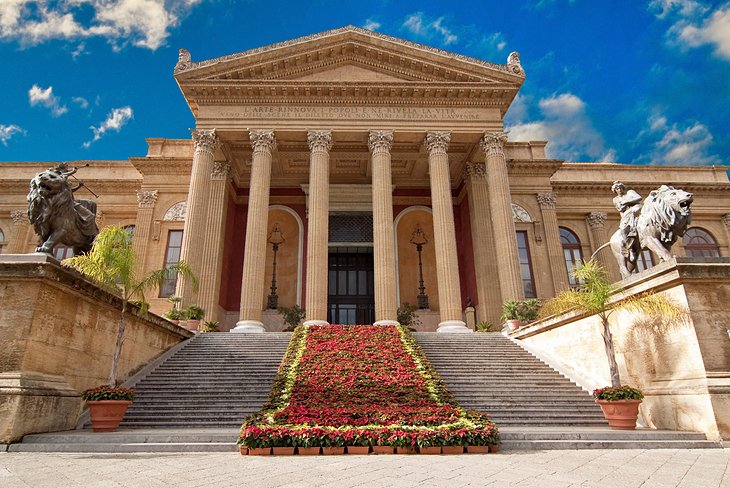
Overlooking the wide Piazza Verde, Teatro Massimo is Italy's largest opera house , and the third largest in Europe. The grandeur of its facade gives only a clue to the magnificence inside. Giovanni Battista Basile and his son Ernesto built this 3,200-seat theater between 1875 and 1897.
It was officially opened with a performance of Verdi's opera Falstaff , and very quickly became one of Sicily's – and Italy's – major opera houses. Along with a full season of opera performances , Teatro Massimo hosts recitals, ballet, and concerts under the baton of such noted conductors as Zubin Mehta.
Daily guided tours in English will take you into the sumptuous auditorium with tiers of boxes and a frescoed dome, but you can get an even closer look on a Backstage Tour with Le Vie dei Tesori. You will go onto the stage itself, to view the magnificent opera house as performers see it, then learn some of the backstage secrets as you view the sets, props, and costumes. You may also learn about the ghost of a nun, who reputedly haunts the opera house.
Address: Piazza G. Verdi, Palermo
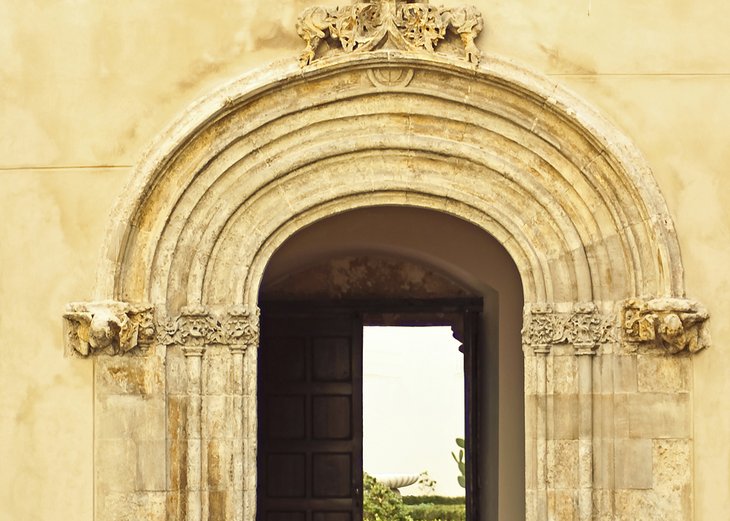
Palazzo Abatellis was built in Catalan Gothic style by Matteo Carnelivari in 1490, for Francesco Abatellis, a highly placed dignitary at the court of King Ferdinand of Spain. It served as a priory from the early 16th- to mid-19th centuries, and today contains the regional art gallery.
The square building has a highly decorated doorway and an inner courtyard with a two-story loggia on one side. The masterpiece of the paintings collection is in the old palace chapel, the large mural Triumph of Death , painted around 1400 by an unknown artist for the hospital in the Palazzo Scláfani.
Outstanding among the 15th-century Sicilian masters are works by Antonello da Messina: three plaques showing the church fathers Augustine, Gregory, and Hieronymus, but in particular, the 1474 Annunciation of Our Lady in portrait form. Works by Flemish masters include the 1510 Triptychon of Malvagna by Jan Gossaert.
Among the sculptures is the posthumous "ideal" portrait of Eleanor of Aragon by Francesco Laurana, from 1480, and Madonnas and sculptures by the Gagini family, including the head of a youth in colored marble by Antonello Gagini. Also worth noting are the woodcarvings, 13th- to 16th-century Moorish ceramics and parts of a wooden ceiling from the second half of the 14th century, removed from the Palazzo Chiaramonte.
Address: Via Alloro 4, Palermo
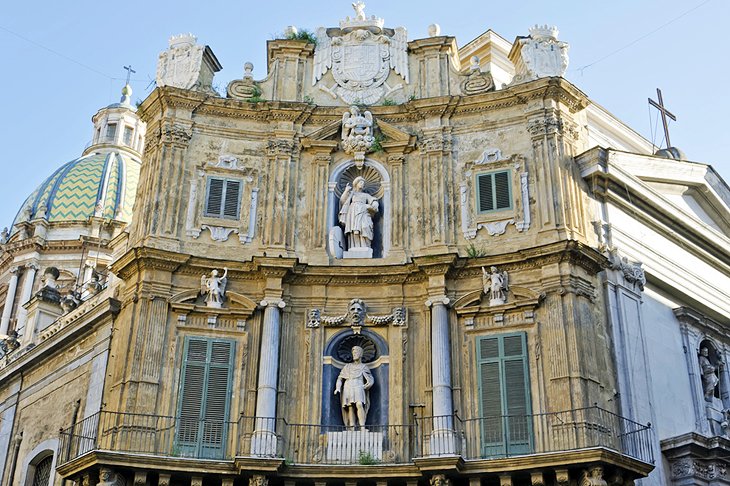
This open circular space was laid out between 1608 and 1620 by the Roman architect Giulio Lasso at the junction of the two major streets in Palermo at that time: Cassarò (now known as Vittorio Emanuele), which leads from the Norman Palace to the harbor, and Via Nuova, later re-named Maqueda after the Spanish viceroy.
Lasso designed this square with a concave frontage on each of the four corners. At ground level on each corner, he built a fountain, with sculptured figures on the three upper floors, accompanied by Classical Greek columns. It was long after 1620 before they were finished; consequently, above the sculptures symbolizing the Four Seasons, it was possible to insert statues of the four Spanish kings since 1516. On the uppermost floor are four female patron saints.
Hidden behind one of the concave corners is the church of San Giuseppe dei Teatini, a large basilica built between 1612 and 1645. You'll find the entrance on Via Vittorio Emanuele. Inside are the dome fresco Triumph of A. Andrea Avellino by Guglielmo Borreman (1724), paintings by Pietro Novelli, and late 18th-century stucco and marble decorations.
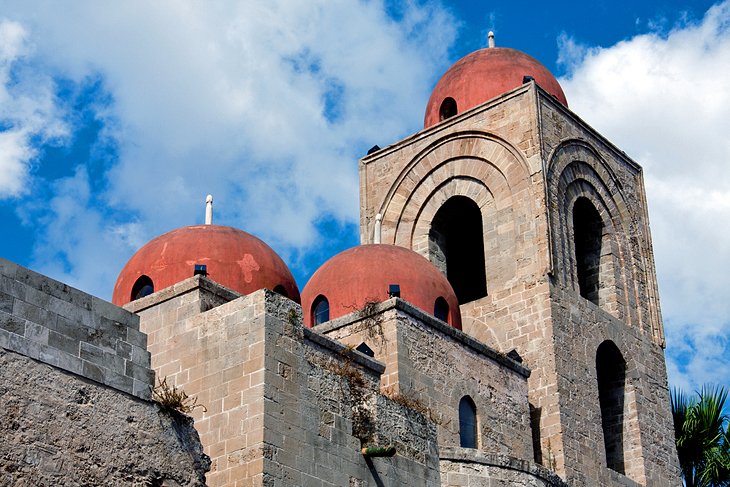
The cloisters of this former monastery are an idyllic place to relax, and perhaps consider the waves of different peoples who have occupied Palermo – and this spot. An Arabic mosque once stood here, and a hall with five arches still stands to the south of the Christian church.
From the sixth century, there was a Benedictine monastery, and the site was re-consecrated under the Normans. In 1132, Roger II built the square church topped by the five domes we see today, originally as a mourning chapel for court dignitaries.
The interior is severe and without much decoration, with geometric shapes and the hemispherical domes adding height to the simple rectangular church. The atmospheric cloisters, only partially preserved, have twin-pillared ogival arcades and the remains of an Arab well in the courtyard.
Address: Via dei Benedettini, I-90100 Palermo
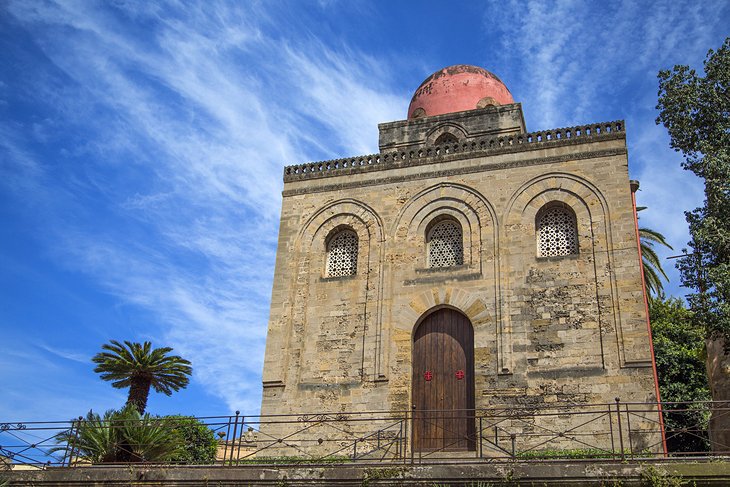
Built immediately next to the Martorana, the church of San Cataldo is distinctive with its bright red dome rising above the decorative cornice. When William I succeeded his father in 1154, he appointed Maio of Bari as Grand Admiral. Maio dedicated his church to a saint from his homeland, Bishop Cataldo of Trani, and chose the Latin ground plan, a triple-aisled basilica.
Its length is emphasized by three Arabic domes above the elevated central nave. Its Arabo-Norman character is also demonstrated by the cubic exterior with three windows on each side surrounded by blind arcades, and the finely carved ledge running around the upper edge.
The same strong, square-shaped masonry is seen inside as well. Apart from the beautifully ornamented inlay of the floor and the Corinthian capitals on the four ancient columns, the inside is entirely without decoration.
Address: Piazza Bellini, 1, Palermo
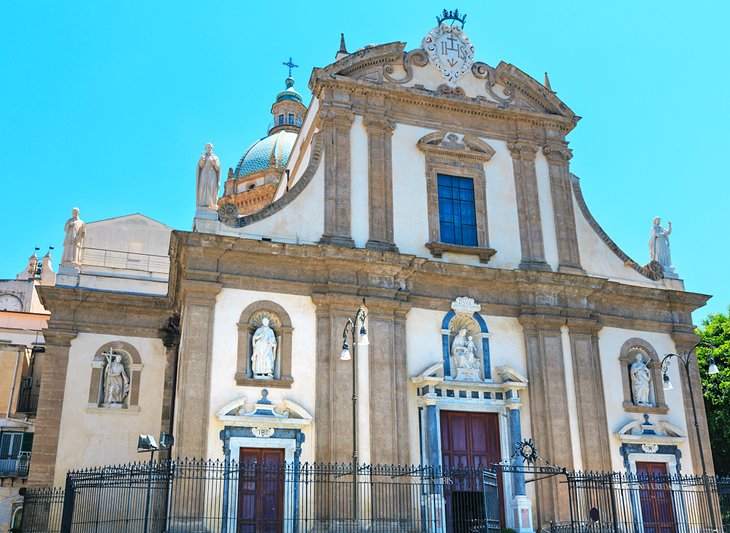
For perhaps the finest view of Palermo and the Conca d'Oro, especially if you can see it in the morning light, go to the former Minorite convent of Santa Maria di Gesù, on the lower slopes of Monte Grifone.
The beautiful original cloister in the priory has been preserved, and inside the church, you'll find the tomb of the founder, Bishop Beato Matteo del Gatto of Agrigento. A monk will guide you to the belvedere, where you can enjoy the fine view.
The adjoining cemetery is interesting as well, with imposing chapels and memorials to Palermo's wealthy families. Among those buried here is Judge Paolo Borsellino, who spent most of his professional life trying to overthrow the power of the Sicilian Mafia. He was killed in a car bombing in 1992.
A path from the cemetery leads up the hill to a 500-year-old cypress tree, thought to be the oldest in Italy. Tradition holds that it grew from a stick thrust into the ground by San Benedetto il Moro.
Address: Salita Belvedere 3, Palermo
The church of Santo Spirito is also known as the Chiesa del Vespro or Church of the Vespers, referring to a dark incident in Palermo's history. It was in front of this church that the Sicilian Vespers-when all the French in Palermo (and later in the whole of Sicily) were murdered or expelled by the Aragonese conquerors-began on March 31, 1282. It was this event that inspired Verdi to write his opera of the same name.
The church was built in 1173-78 as the oratorium of a Cistercian abbey outside the city walls at the time. Over the years, it was frequently altered, especially when the viceroy Domenico Caracciolo had the abbey pulled down in 1782 to make room for the new cemetery. It was not until 1882, the 600th anniversary of the Sicilian Vespers, that it was restored in its original form.
The north side is impressively colorful, as is the east side with the crossed arches of the three apses made from lava. You can see signs of earlier abbey-buildings in the south transept. The interior, with a tall chancel and two rows of round pillars supporting the Gothic arcades, reflects the strictness of the Cistercian Order.
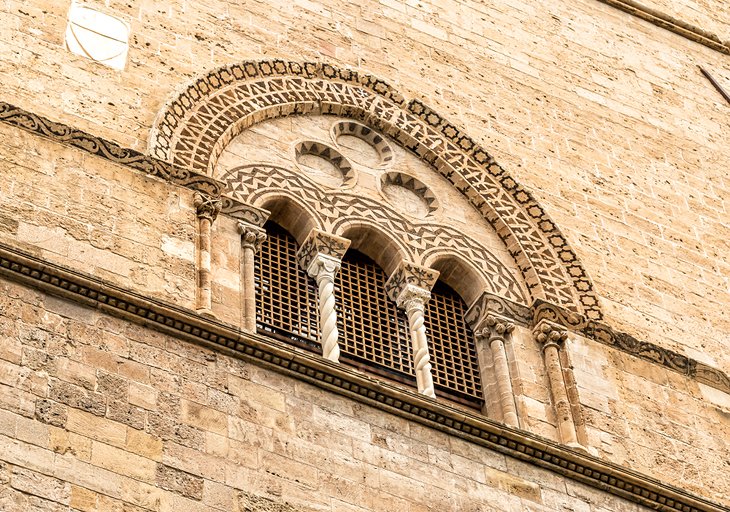
This palace was built by the powerful noble Chiaramonte family from Agrigento in the 14th century, when the family reached the height of its power. Work commenced in 1307 and continued until 1380, but the second floor was never completed. In 1396, Andrea Chiaramonte was publicly beheaded in front of his palace because he had rebelled against the king.
The palace served as the viceroy's residence between 1468 and 1517, as the seat of the Inquisition around 1600, and as a courthouse from 1799. The massive block building with four wings around a square inner courtyard is now a museum.
The first floor has some beautiful windows with pillared arcades; the 14th-century painted wooden ceiling of the Sala Magna (Great Hall), by Cecco di Naro, Simone da Corleone, and Pellegrino Darena, shows historical and legendary themes.
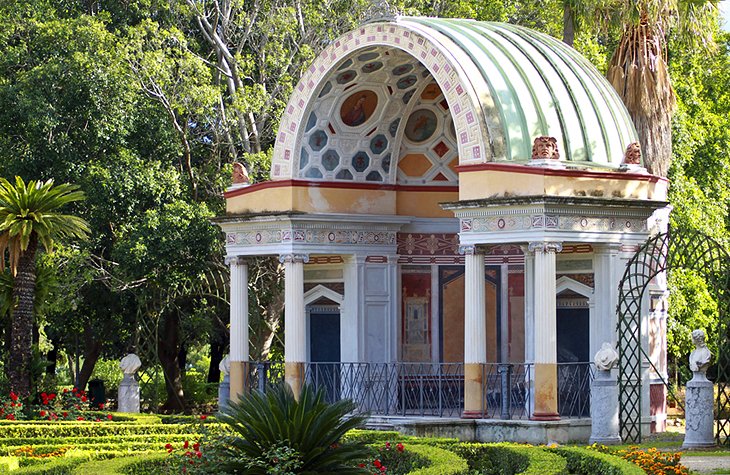
Along the seafront to the east and southeast of the Porta Felice extends the Foro Umberto I, a broad boulevard with magnificent views of the Bay of Palermo. On warm evenings, it seems as though half of Palermo is enjoying a stroll here. At the southern end of the Foro Umberto I is the beautiful Villa Giulia park, also known as La Flora, laid out in 1777.
On the west side of this, the Botanic Garden (Orto Botanico) has a magnificent variety of plants, including date and coconut palms, banana trees, and fine stands of bamboo and papyrus. The garden, one of the most important in Europe, covers 11 hectares, and between its beds and hot-houses contains more than 12,000 species of plants from all over the world.
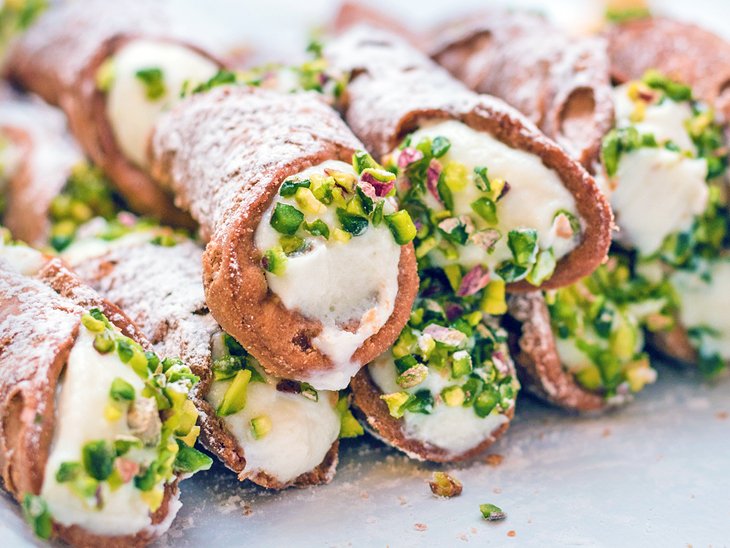
One of the most memorable things to do in Sicily is sampling this island's outstanding regional foods. Based on local products-a bounty of seafood, lemons, oranges, year-round fresh farm vegetables, pistachio nuts, almonds, olives, and locally made cheeses-the traditional dishes of Sicily are simple in their ingredients, but complex in their flavors. Whether you choose fine dining restaurants or humble little neighborhood trattorias, you'll be well fed.
Luxury Hotels:
- For old-world elegance in a Neoclassical building furnished in antiques, choose the Grand Hotel Wagner , near the central attractions and an easy walk to old town and shopping. There's a fine-dining restaurant, a rooftop terrace, and spa and sauna.
- The 16-room boutique Alma Hotel is in the center of Palermo, and its spacious rooms are equipped with a desk, safe, minibar, kettle with tea selection, as well as extra pillows, slippers, and an amenity kit filled with bath and beauty products. The complimentary breakfast buffet is bountiful.
Mid-Range Hotels:
- Right in the historic center and surrounded by restaurants, the four-star Grand Hotel Piazza Borsa has a lovely glass-covered atrium with a fountain, as well as a spa with a hot tub and steam bath.
- In the historic center near Corso Vittorio Emanuele, Hotel Porta Felice has 30 rooms and three suites, as well as a full-service spa with a sauna, steam bath, and hydro-massage pool. Breakfast is served on the rooftop terrace.
Budget Hotels:
- Centrally located near the bus and cable car stations, Hotel Ariston is a short walk from restaurants and shopping. Rooms are equipped with coffee makers, and some have sea views. Breakfast is included in the rate.
- Although it's not as centrally located, Casena dei Colli makes up for that with its garden setting, surrounded by green space, a welcome oasis in a busy city. It is equidistant from the city center and the beautiful beach of Mondello, and offers free parking, a blessing for guests touring Sicily by car. The included breakfast has hot and cold dishes with an emphasis on local products.
More Related Articles on PlanetWare.com
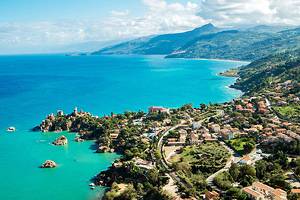
What to See near Palermo: Just a few kilometers from the city, you can explore one of Sicily's top attractions with our visitor's guide to Monreale Cathedral . Not far west of the capital is the historic port of Trapani , and the same distance to the east is the lively town of Cefalu , with a beach at its feet.
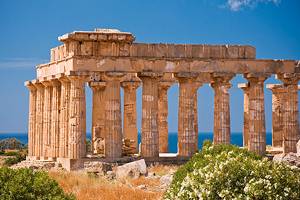
Discovering Sicily's Ancient Sites: While you're exploring the western end of the island, you can find an acropolis and eight Greek temples at Selinunte, an easy day trip from Trapani . On the southern coast, Agrigento achieved UNESCO status for its Valley of the Temples, and outstanding Greek and Roman theaters are among the tourist attractions of Syracuse .
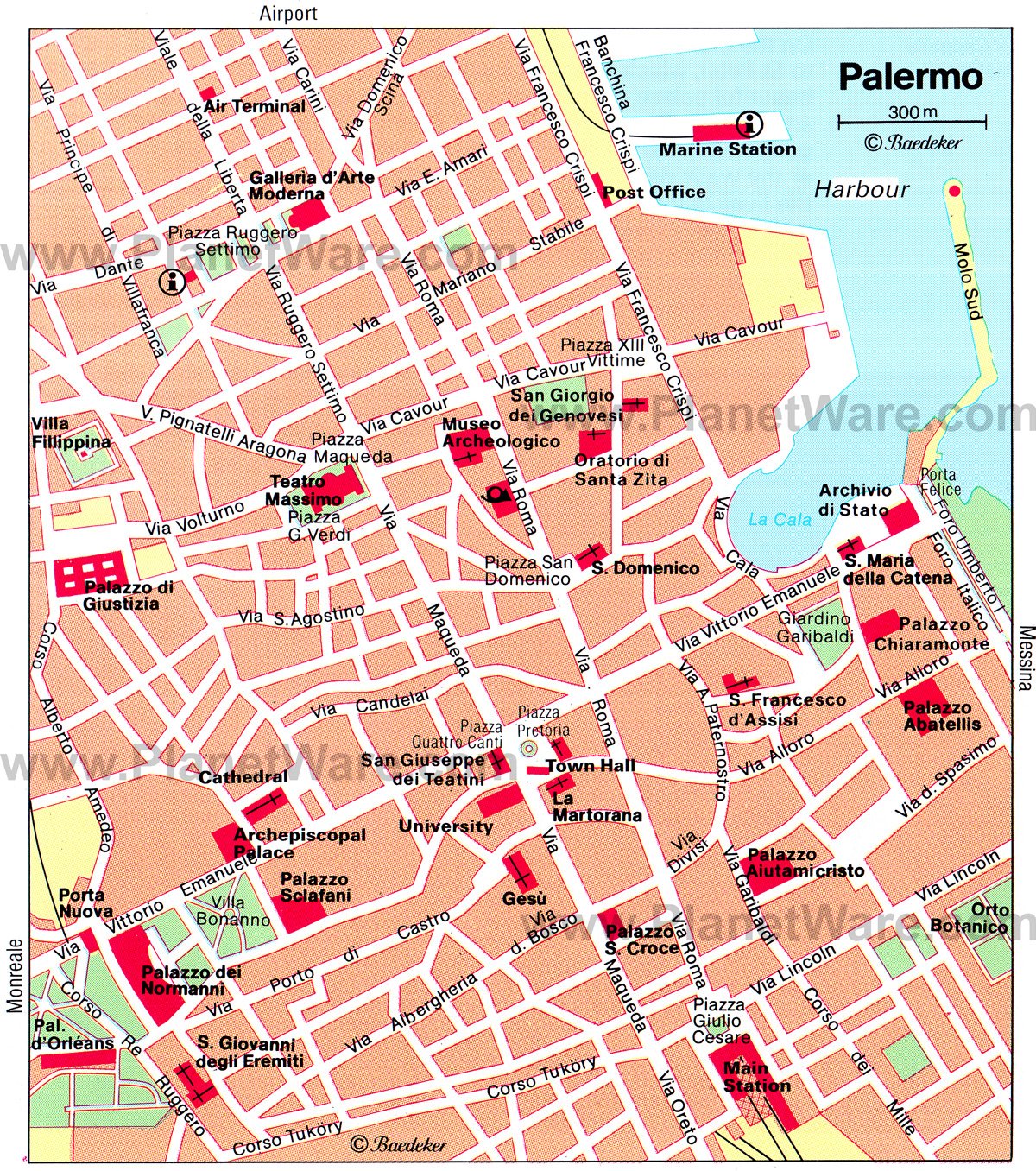
More on Italy

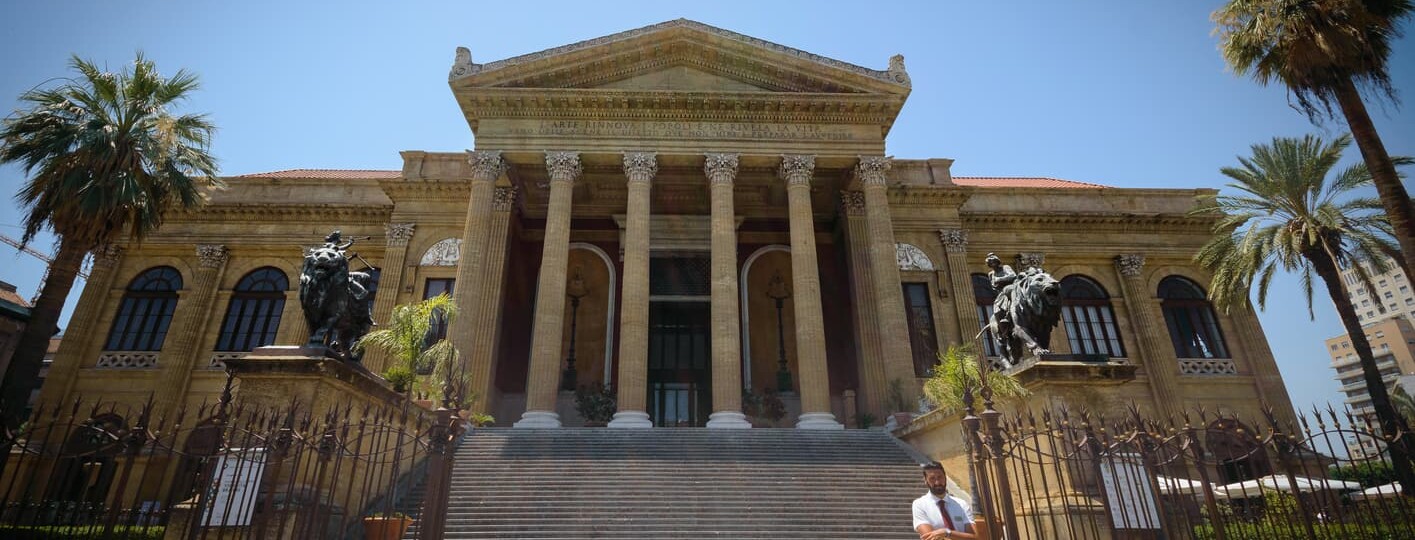
25 Best Things to Do in Palermo, Sicily (Italy)
Home | Travel | Europe | Italy | Sicily | 25 Best Things to Do in Palermo, Sicily (Italy)
When traveling abroad, get a policy from one of the best travel insurance companies . You can get a 5% discount on Heymondo , the only insurance that pays medical bills upfront for you, HERE!
If you need help finding the best things to do in Palermo , the capital of Sicily, Italy, I’m here to share some must-see places.
We started our 10-day Sicily itinerary in Palermo and, although you can see the main attractions in Palermo in one day, we spent one night here. The city is a popular stop for Mediterranean cruises, as one day in Palermo gives you plenty of time to see the highlights.
So, our guide will tell you all the fun places to go in Palermo, Sicily, as well as the surrounding areas in case you have more time.
At the end of the article, I’m sharing the best neighborhoods to stay in Palermo, where to eat, and a map of the city’s tourist attractions.
Regardless of how much time you spend in the city, this free tour is perfect for first-time visitors. We enjoyed this two-hour guided tour, as it introduced us to some of the main points of interest in Palermo. If you’re short on time, also consider this hop-on hop-off bus tour to make the most of it.
Now, let’s check out the best things to do in Palermo, Italy , one of the top places to visit in Sicily .
1. See Norman Palace, a great activity to do in Palermo
The Norman Palace, also known as the Royal Palace, is a must-see in Palermo , as it’s one of the most important buildings in the city. It currently serves as the seat of the Sicilian Parliament.
The palace’s façade features a combination of architectural styles, making it one of the best places in Palermo to visit. The right side of the façade has an Arab-Norman-Byzantine style, which reflects the palace’s 12th-century origins. The left side was constructed a few centuries later in the Baroque style, which was popular back then.

Be sure to go inside because the interior is even more impressive. You’ll see the Palatine Chapel, which many consider a city gem. What makes this chapel so unique is that Byzantine, Islamic, and Latin architects worked on it, and yet, all the decorative elements come together beautifully. One of the most magnificent parts of the chapel is the mosaics, many of which cover the ceiling.
While you can visit the Norman Palace and the Palatine Chapel on your own, this guided tour will show you the palace and several historical monuments. It’s one of the best Palermo activities for art lovers.
2. Palermo Cathedral, a lovely place to visit in Palermo, Sicily
Palermo Cathedral was built at the end of the 12th century at the request of the Archbishop of Palermo. His goal was to replace the Christian basilica in the city, which previously replaced a Muslim mosque. Ideally, the new cathedral would rival the Cathedral of Monreale, and if you ask me, it definitely does.
Today, the cathedral is one of Palermo’s main attractions , despite its constant architectural makeovers. Over the centuries, the church’s structure and appearance have changed, and you can still see evidence of these renovations if you look closely.
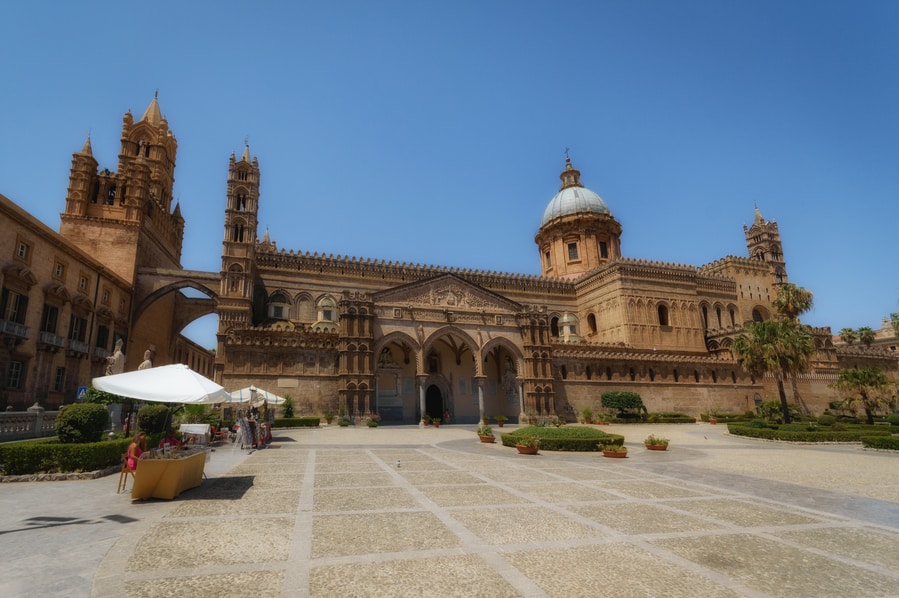
For example, you can find parts of the original Norman structure, as well as Gothic vestiges, Neoclassical elements, and even Arabic-style ornamentation. Somehow, all these visual motifs come together to create an incredible building, so if you only have one day in Palermo , check it out.
If you go inside, you can also visit the “Treasure of the Cathedral,” a collection of royal and religious objects like sacred ornaments, chalices, vestments, and Constance of Aragon’s gold tiara. It’s one of the most interesting things to do in Palermo, Italy , especially if you’re into history.
3. Catch a show at Massimo Theater, an exciting thing to do in Palermo
The Massimo Theater , or Teatro Massimo, is the largest opera house in Italy and among the largest in Europe. You’ll find it in Piazza Verdi, Palermo’s city center.
This magnificent neoclassical theater was the work of Giovan Battista Filippo Basile, although his son, Ernesto Basile, finished the project after his father’s death. Step inside and enter an elegant atmosphere of lounges, galleries, and the main theater.
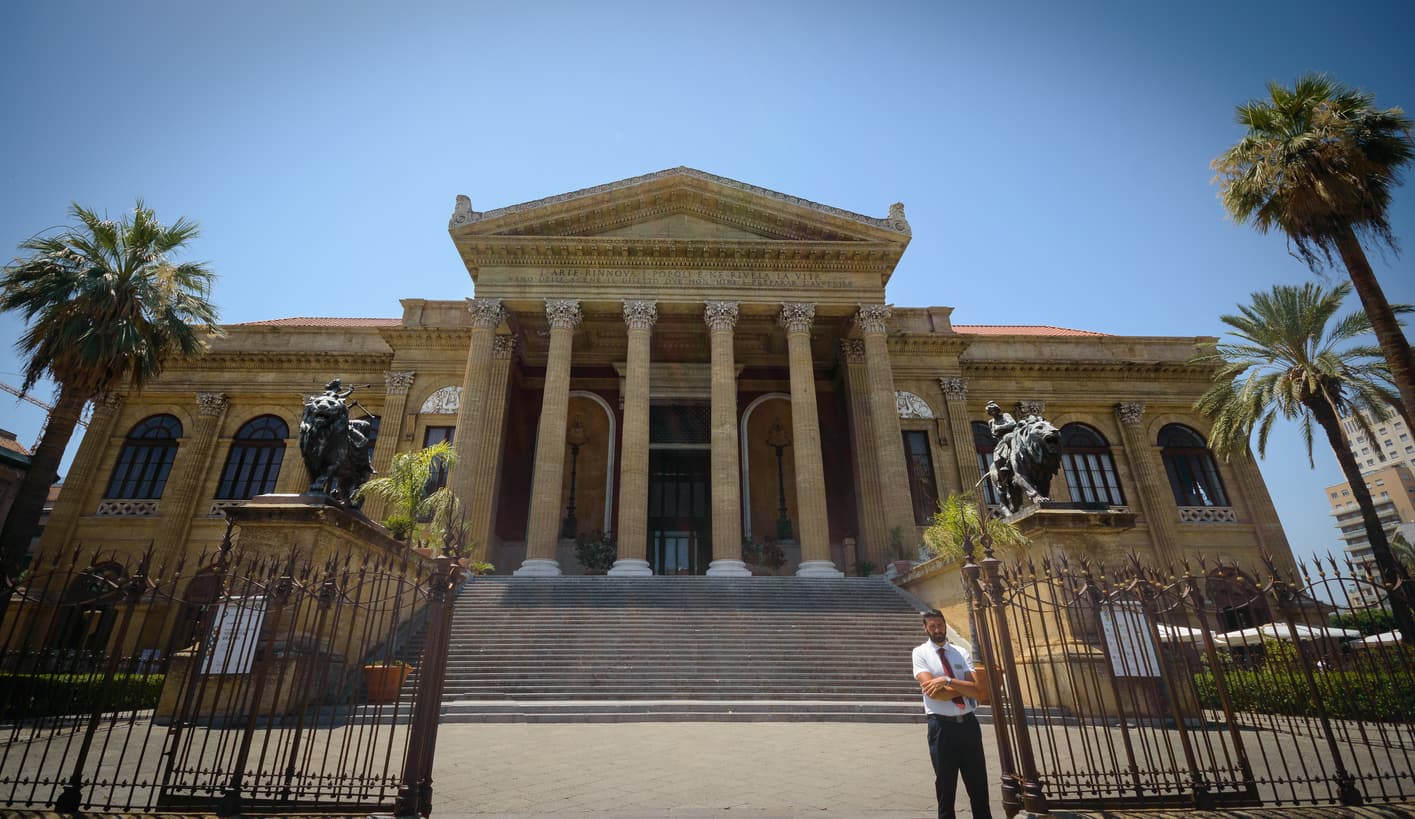
Visiting this opera house was one of the coolest things to do in Palermo during our trip. We learned that several nearby buildings were demolished to make way for the theater. Among those buildings was the Church of the Stigmata, its convent, and the Church of San Giuliano. Ever since then, there has been an urban legend about one of the nuns from the destroyed convent wandering the halls of the theater.
However, don’t let a ghost story stop you from visiting the opera house. Tickets to the Massimo Theater are quite expensive, so a good alternative might be a guided tour. This is one of the top places to visit in Palermo , so check the theater’s official website for more info about these daily tours.
4. La Vucciria & other ancient open-air markets in Palermo
There are several markets in Palermo that are worth visiting. One of the most popular sights to see in Palermo is La Vucciria market, where you can find all kinds of southern Italian products, most notably, anchovies.
This historic market is one of the best places to go in Palermo , as it’s spread out along different streets and plazas. For example, it passes through via Roma, la Cala, il Cassaro, via Cassari, piazza del Garraffello, via Argenteria Nuova, piazza Caracciolo and via Maccheronai. I suggest starting at Via Roma and making your way through the wonders of this market.
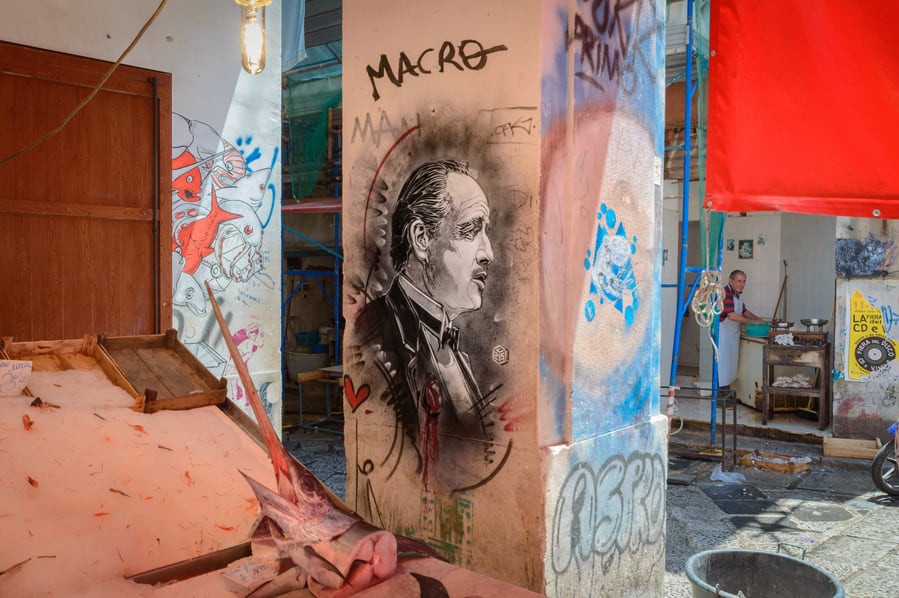
4. La Vucciria & other ancient open-air markets, a must-see in Palermo, Sicily
Besides La Vucciria, the open-air market of Il Capo is another must-visit in Palermo. Here, you can browse through stalls of clothes, fabrics, kitchen utensils, fruits, vegetables, meat, fish, and much more. Il Capo market is on Via Cappuccinelle, close to the Teatro Massimo, but I’m sure you’ll hear the shouts of the vendors before you see them!
I also recommend stopping by the Ballarò market, which stretches along Via Ballarò almost to the central station. It’s one of the oldest food markets in Palermo, so you can’t miss it. That said, whichever market you go to, it’ll be a fun, free thing to do in Palermo while immersing yourself in the local culture.
5. Capuchin Catacombs, a unique place to go in Palermo, Sicily
Visiting the Capuchin Catacombs is one of the most unusual things to do in Palermo , but it’s also cool, as long as you aren’t squeamish.
These catacombs sit under the convent of the Order of Friars Minor Capuchin, which served as a cemetery in the 16th century. The friars were surprised after discovering, by accident, how well the bodies were preserved and many people began requesting they be buried in the catacombs.
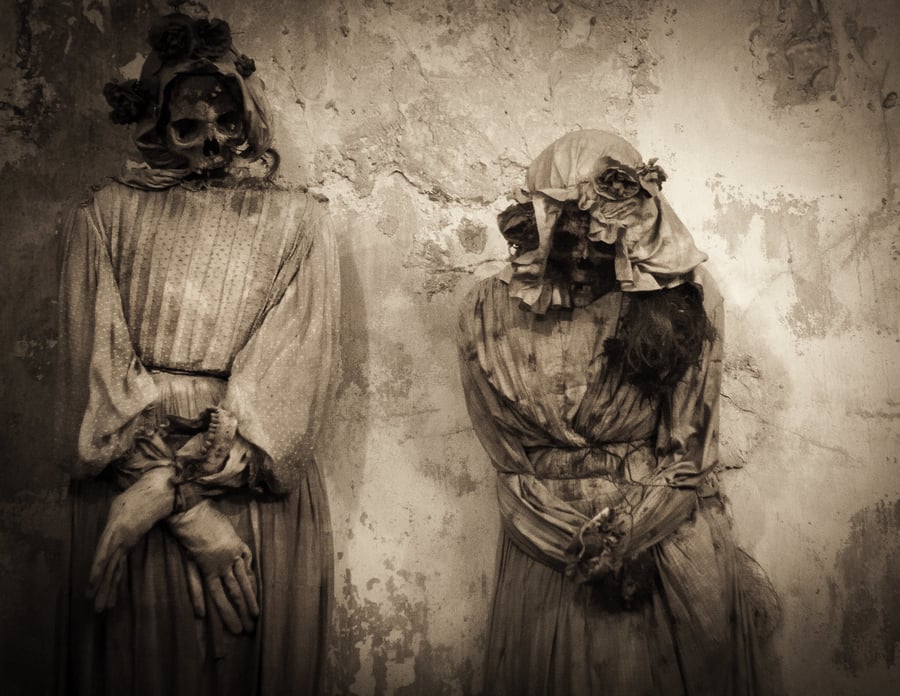
Now, there are around 8,000 corpses here, and they’re laid out according to age, sex, and profession. Some of them hang from the walls of the underground corridors, while others rest in or on caskets. This is certainly one of the more bizarre attractions in Palermo , but I thought it was more curious than unpleasant.
If you dare to see what’s going on in the Capuchin Catacombs, I suggest this sightseeing tour . It also includes a visit to the 12th-century cathedral of Monreale, another great Palermo site to visit .
6. Piazza Pretoria, one of the top places to go in Palermo
Piazza Pretoria is another beautiful place to see in Palermo, Sicily . The plaza is best known for its Fontana Pretoria, a monumental fountain built in the 16th century by Francesco Camilliano.
Originally, the fountain was going to adorn the private garden of a Florence mansion, but it was eventually brought to Palermo. The large fountain includes 16 marble statues of nude mythological creatures, such as nymphs, mermaids, satyrs, and the twelve Olympians. The fountain later became a symbol of government corruption, giving the plaza the nickname Piazza della Vergogna (Square of Shame). That said, a tour of Palermo wouldn’t be complete without seeing the Pretoria Fountain.

Other iconic buildings surround the square, including the Palazzo Pretorio, which dates to the 14th century and now houses Town Hall; the Church of Santa Caterina; and two stately palaces, the Palazzo Bonocore and the Palazzo Bordonaro.
Piazza Pretoria’s charming beauty and historical significance make it a great place to spend a day in Palermo , so I suggest checking it out.
7. Cathedral of Monreale, something you must see in Palermo
The Cathedral of Monreale is one of the most famous cathedrals in Italy and a UNESCO Heritage Site, so visiting it is one of the best things to do in Palermo, Sicily . If you’re going to be in the city for more than one day, I highly recommend seeing this amazing church.
It dates to the 12th century and was founded just a few years before the Cathedral of Palermo. During its construction, Norman and Arabic art were prevalent in this area, resulting in a beautiful cathedral with historical significance. However, what really makes this church famous is the display of Biblical mosaics inside.
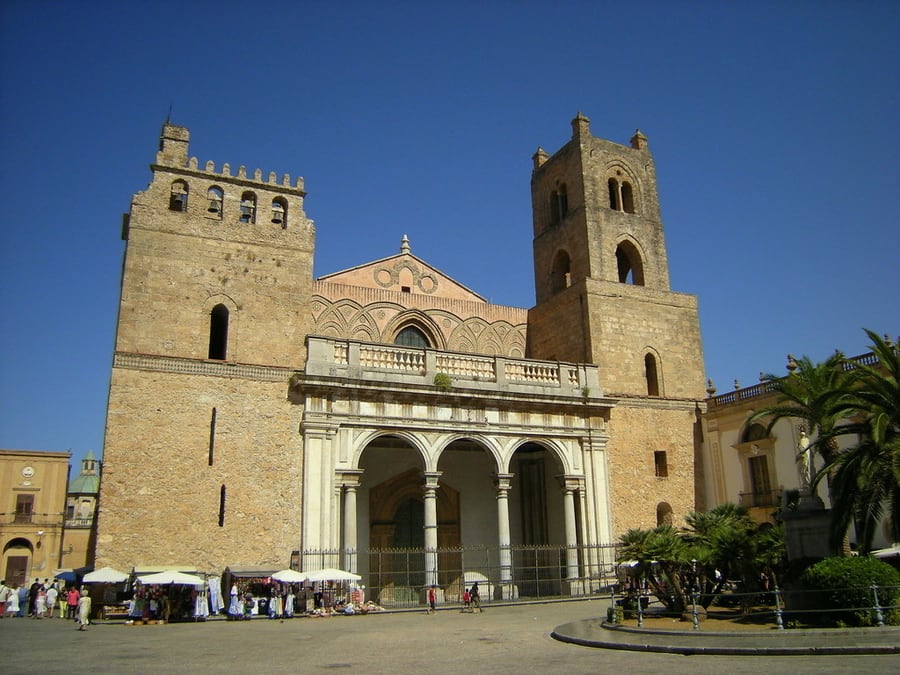
As I mentioned before, there has always been a rivalry between the Cathedral of Palermo and the Cathedral of Monreale. You can do a tour of Palermo and decide for yourself, but as for me, I can’t say which is more beautiful, as they’re both so impressive!
That said, be aware that the Cathedral of Monreale is on the outskirts of the city. If you don’t have a car, you can find a tour that visits this area of Palermo. I recommend this tour , which includes a visit to the Capuchin Catacombs. However, if you prefer less-scary Palermo activities , this tour combines the Cathedral of Monreale with the Cefalù Cathedral.
8. Quattro Canti, the best thing to visit around Palermo
Quattro Canti is one of the most iconic places to visit in Palermo . This square, also known as Piazza Vigliena, sits at the intersection of two main streets, Via Maqueda, and Il Cassaro.
This is a symbolic plaza, as well as a lovely attraction in Palermo . Despite its octagonal layout, the square has four corners, each adorned with a fountain and three statues. The statues at each fountain represent a season of the year, one of the four kings of Spain in Palermo, and one of the four patron saints of the city.
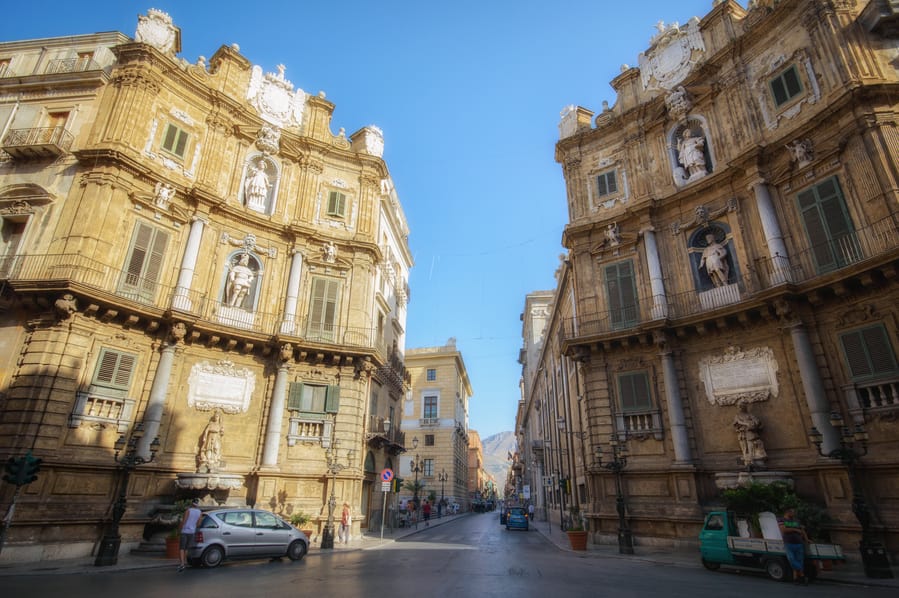
8. Quattro Canti (Piazza Vigliena), the best thing to visit around Palermo
For example, the northern corner’s statues represent autumn, King Philip IV, and Saint Oliva di Palermo. The eastern corner’s statues represent winter, King Philip III, and Saint Agatha of Sicily.
As for the fountains, they also hold special significance, as they preserve the memory of the ancient rivers that once flowed through the city. The two most important ones were the Kemonia and Papireto rivers. Today, the fountains and the entire square is an area of bustling activity and is a must-see in Palermo.
9. Martorana & Church of San Cataldo, the best churches in Palermo
La Martorana , also known as the Church of Santa Maria dell’Ammiraglio, is one of the most beautiful places to visit in Palermo, Italy . It’s in Piazza Bellini and its mix of architectural styles makes it one of the most popular buildings in the city.
The left side of the building is the original Arab-Norman structure, but the Baroque-style architecture was added later to the right side. The combination creates a lovely artistic and historical display, which is why visiting it is one of the best things to do in Palermo . If you go inside, you’ll find some spectacular Byzantine and Arab mosaics.
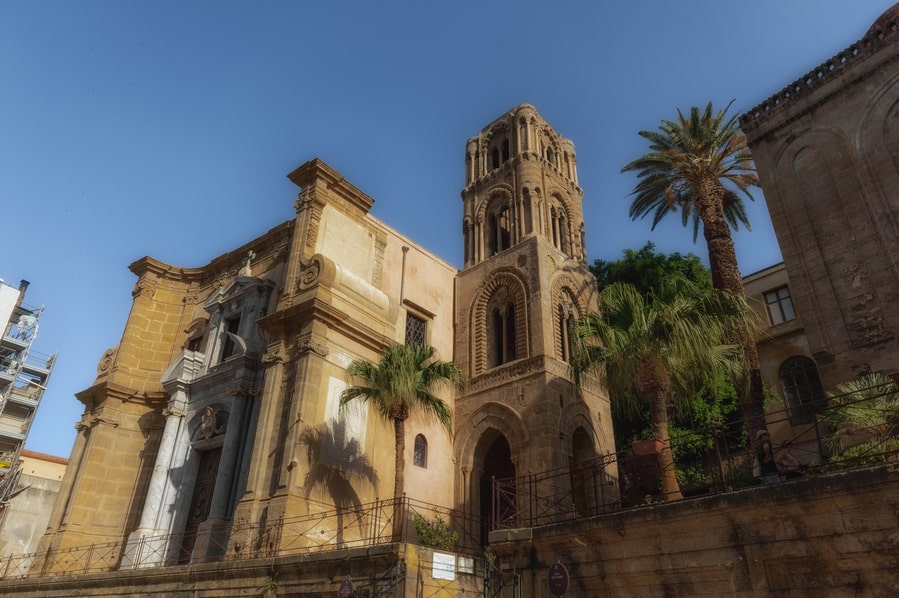
Right next to La Martorana is the Chiesa di San Cataldo , which stands out for its three pink domes over the central nave. Although it was built as a place of worship back in the 12th century, the church has had various uses throughout history and wasn’t re-consecrated until the 20th century.
Both La Martorana and the Church of San Cataldo are UNESCO World Heritage Sites, so they’re both essential sites to visit in Palermo .
10. Enjoy the street food of Palermo
Palermo is the European capital of street food , so if you aren’t sure what to do in Palermo , you can find plenty of places to grab a bite to eat.
Near the markets I mentioned earlier, Vucciria, il Capo, and Ballarò, you’ll find various street food carts. The city of Palermo has a strong street food culture, so it’s almost required that you try some of the typical dishes here.
My favorite is the arancini , which is a ball of rice coated with bread crumbs and then deep-fried, and filled with cheese or meat. And of course, I love cannoli , the pastry dough stuffed with ricotta! I also recommend panelle (chickpea fritters) and crocché (potato croquettes). Not only are these foods delicious, but they’re also very inexpensive, so you can try them all.
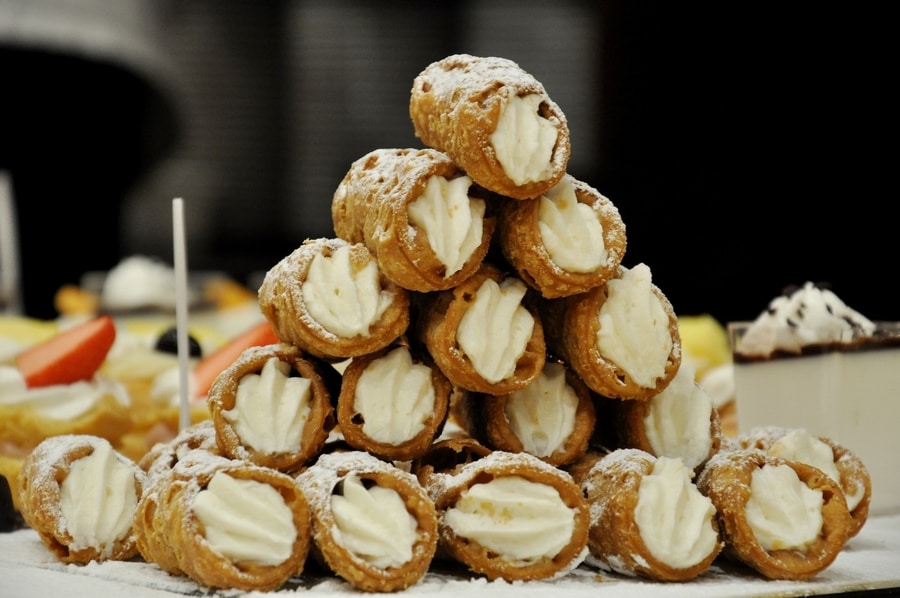
10. Enjoy the street food of Palermo, an amazing thing to do in Palermo in one day
Beyond Palermo’s downtown food stalls, I recommend trying some proper local dishes, such as pasta con le sarde (pasta with sardines). However, if sardines aren’t your thing, you can try pasta alla Norma , which has tomato, fried eggplant, grated ricotta, and basil.
You can also try involtini alla palermitana , Palermo-style rolls with spicy salami, raisins, and pine nuts. Or falsomagro , stuffed pork chops with ham and cheese.
It’s not a visit to Italy unless you enjoy all the food, so I recommend this food tour all about Palermo’s gastronomy.
11. Regional Archaeological Museum Antonio Salinas, another place to visit in Palermo
The Regional Archaeological Museum Antonio Salinas has one of the most important collections of ancient art in Italy, so it’s one of the main attractions in Palermo .
The museum has three collections, the Collection of the University Museum, which is the oldest; the Antonio Salinas Collection, which is the largest with more than 6,600 pieces; and the Pietro Bonci Casuccini Collection, which is considered the most important collection of Etruscan art outside of Tuscany.

The most valuable objects in the museum come from Pompeii and Torre del Greco, although the collection of Sicilian historical and cultural objects is also interesting. The museum also has ancient sarcophagi, Phoenician and Roman objects that were retrieved from the sea, a reproduction of the Temple of Selinunte, and the famous Palermo Stone.
As you can see, this museum is an awesome place to visit, and I recommend adding it to your Palermo itinerary . Or you can keep it in mind if you find yourself in the city on a rainy day.
12. Church of St. John of the Hermits, a stunning place to go in Palermo
Along with the Capuchin Catacombs, the Church of St. John of the Hermits is one of the most internationally known tourist places in Palermo, Sicily .
The church is in the Albergheria neighborhood and is famous for its five red domes, which stand out against the simple facade. The cloister of the church is quite impressive, with a well and a courtyard of trees and shrubs. It was built after the church was established, although the two areas work nicely together.
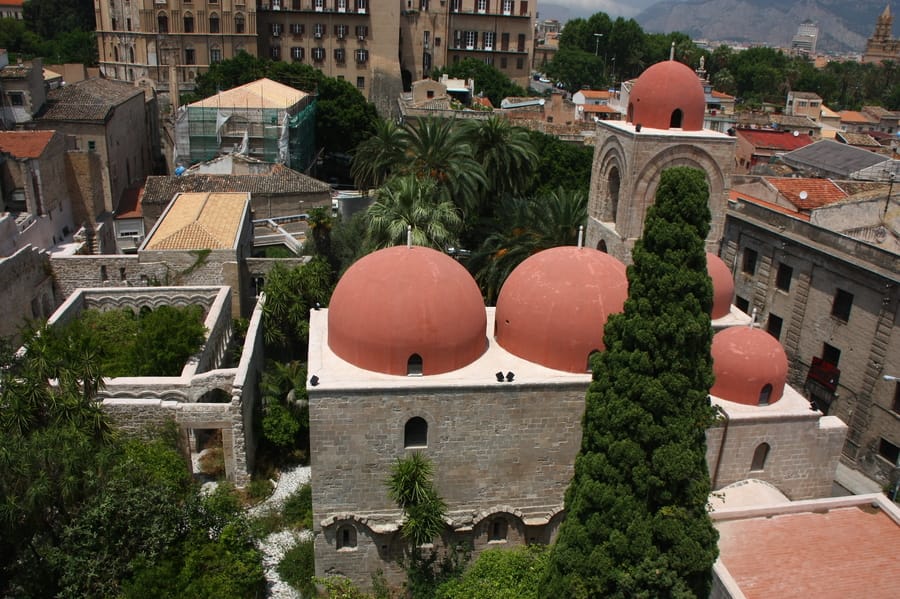
If you visit this attraction in Palermo , be sure to check out the cloister. From there, you can get a beautiful view of the red domes, as well as the bell tower next to it. There are also some columns in the courtyard that have vegetable motifs on them.
Parts of the church may be in ruins now, but the building still holds great historical value, and it’s even a UNESCO World Heritage Site, so it’s an interesting place to visit in Palermo .
13. Mondello Beach, one of the best beaches in Palermo, Sicily
Mondello Beach is just 8 miles from the city center, right at the foot of Mount Pellegrino. It’s a gorgeous beach with white sands and crystal-clear waters, not to mention beautiful views. If you’re visiting during the warmer months, seeing Mondello is one of the top things to do in Palermo, Italy .
Locals and tourists alike go to this beach for its pristine waters and relaxing atmosphere. During the day, you’ll find sunbathers and families enjoying the sunny shores. By night, the terraces on Mondello Pier host patrons for seaside dinner and drinks.
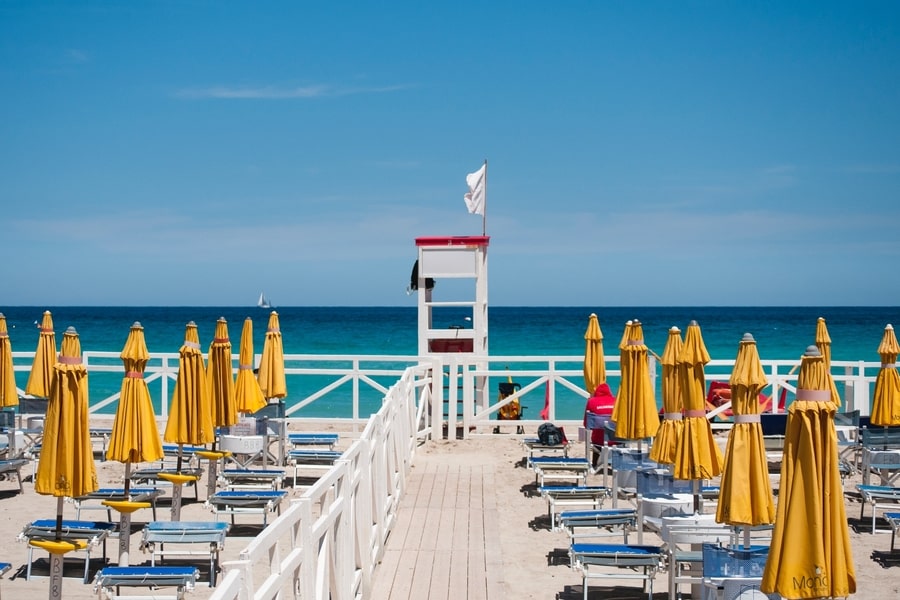
Mondello was once a small fishing town, but it has grown into a more sophisticated vacation destination. One of the best things to do here is to hang out in a villa or terrace along the waterfront promenade. It’s a great way to end a fun beach day.
This village isn’t too far from Palermo, but you’ll have to take public transportation if you don’t have a car. The 806 bus leaves from the city center and stops at Mondello. It might be better to take the bus, as parking spots are hard to find at this beach, especially in the summer.
If you only have one day in the city, you can skip this beach, but if you have time and you’re wondering what to do near Palermo , Mondello is a stunning Sicilian beach you won’t regret visiting!
14. Zisa Castle, the best attraction in Palermo, Sicily
Zisa Castle is tucked away in the western part of the city, but it’s a must-see in Palermo . It’s another UNESCO World Heritage Site and dates to the 12th century. The castle was built by Arabian craftsmen for King William I and later became a summer palace for the Norman kings.
In Arabic, the palace is referred to as the “Earthly Paradise,” and once you see it, you’ll understand the splendor of this place. Built in the middle of a manmade lake, the castle is surrounded by a lush garden. The facade reflects its Moorish origins, and Zisa literally translates to “splendid” in Arabic.
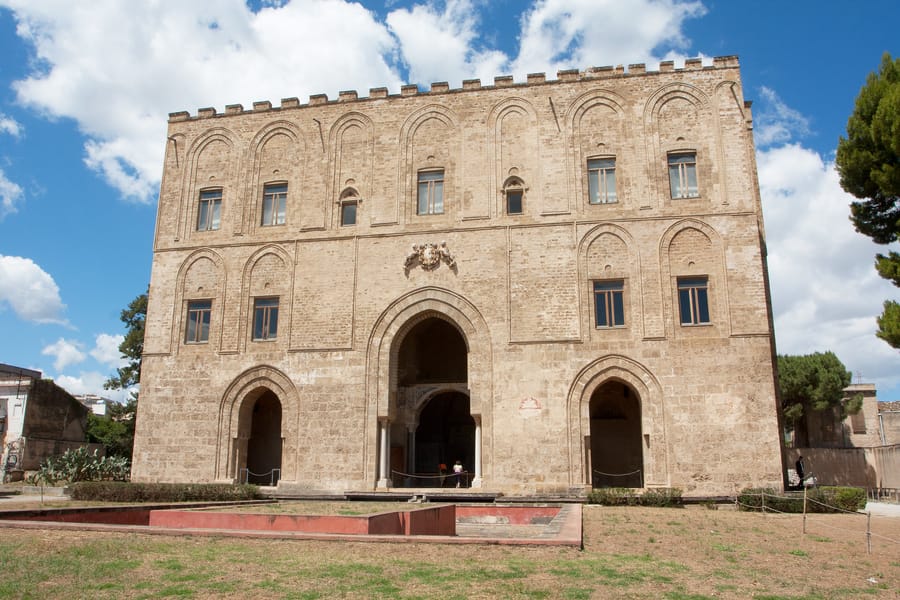
Along with the lovely exterior, Zisa Castle also has an Islamic art exhibit in several of its rooms and is open to the public. You should also stop by the ‘Fountain Room’ the main foyer area with wall and ceiling frescos.
If you only have one day in Palermo , I suggest hopping on the Palermo sightseeing bus , which has 14 stops, including Zisa.
15. Church of Saint Mary of Gesu, something you must visit in Palermo
The Church of Saint Mary of Gesu , also known as Casa Professa, is one of the most important Baroque sights to see in Palermo . In fact, it’s a prominent church in all of Sicily.
The Jesuits built this church in the late 1500s after arriving in the Jewish quarter of the city. While the original plan was to construct a rather simple church, the building became more ornate in the early 1600s and was consecrated in 1636.

This church is one of the most impressive places to visit in Palermo . The layout reflects the shape of a Latin cross, and the interior is filled with frescoes, marble bas-reliefs, and decorative Biblical motifs. The central nave is nearly 230 feet tall, giving the structure a grandiose feeling. Be sure to take your time while you’re here to look all around, as well as to the ceiling, as there is artwork everywhere.
Interestingly, the church’s exterior looks austere and unassuming, so it contrasts quite a bit with the elaborate interior. That said, the church is a UNESCO World Heritage Site and one of the most stunning attractions in Palermo , so don’t miss it!
16. Mount Pellegrino, the best place to see the sunset in Palermo, Italy
Visiting Mount Pellegrino is one of the best things to do near Palermo , especially if you’re with a special someone. The German writer Goethe said this mountain was the most beautiful promontory in the world, and I must agree.
Mount Pellegrino has an altitude of about 2,000 feet, and it overlooks the Bay of Palermo and the Tyrrhenian Sea. Watching the sunlight glimmer on the crystalline waters is so relaxing and can be a romantic thing to do in Palermo.
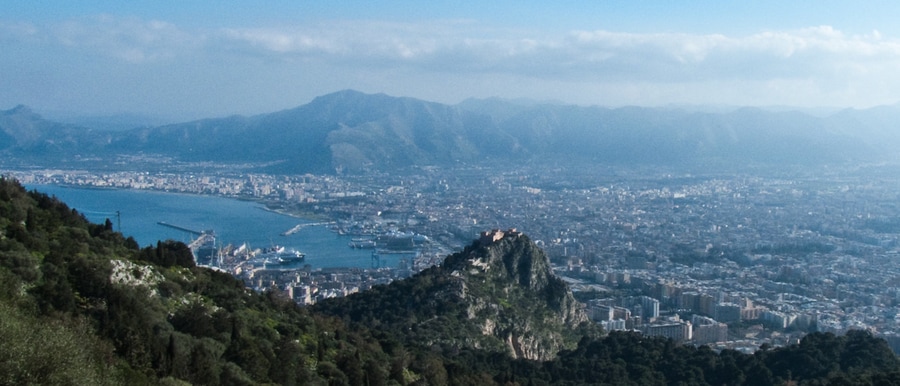
Near the mountain’s summit, you’ll find the Sanctuary of Saint Rosalia , who is the patron saint of Palermo and a popular place where Sicilians go to pray for healing.
You’ll also find the Mount Pellegrino Nature Reserve here, although it’s split between Mount Pellegrino and Favorita Park. This is one of the best places to go in Palermo to see the sunset, as well as to get some exercise. You can go up the hill on foot or opt for a bus or car ride.
If you decide to walk, there are two paths. The Rosalie Itinerarium route is paved, while the Gola del Porco route is older and goes into Favorita Park. You could also drive along the scenic mountain road or take the 812 bus to the Sanctuary.
Regardless of how you get there, Mount Pellegrino makes for a fun half-day trip in Palermo , so consider visiting if you have the time.

17. Villa Giulia & the Palermo Botanical Garden
Villa Giulia is the oldest public park in the city and a wonderful place to visit in Palermo. Also known as Villa Flor, it’s home to some of the most beautiful botanical gardens in all of Sicily.
If you’re looking for fun outdoor activity in Sicily while escaping the heat, check out the Palermo Botanical Garden . The area doubles as a research and education institute and houses hundreds of tropical and semi-tropical plants from all over the world. The garden spans 30 acres, including an aquatic plant display, several greenhouses, and an herbarium.
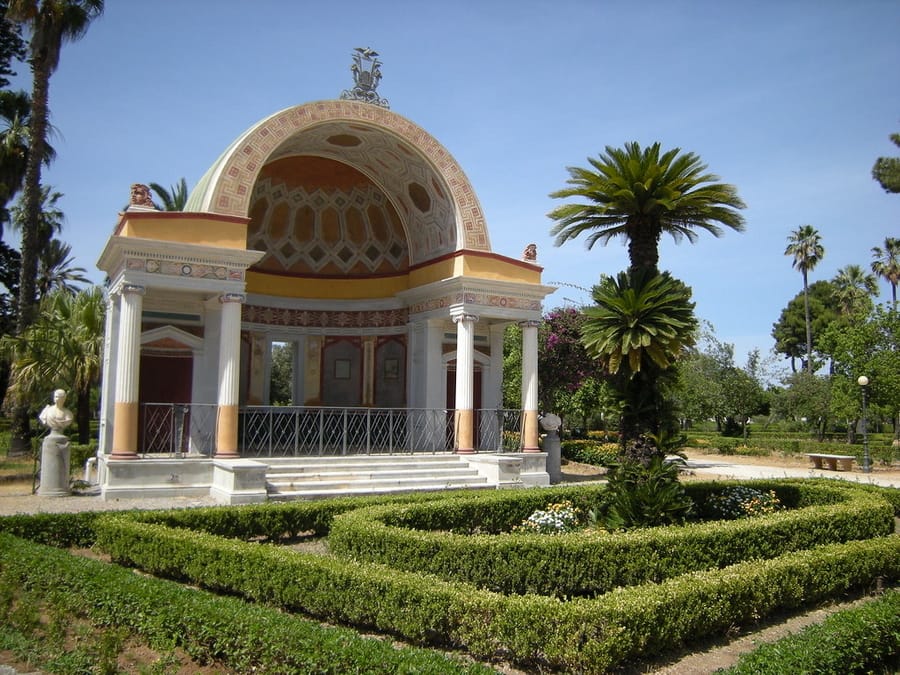
17. Villa Giulia & the Palermo Botanical Garden, a breathtaking place to go in Palermo
Also in Villa Giulia is the Foro Italico , a large oceanfront lawn where you can walk, jog, relax, or have a picnic. It’s a great place to rest before making your way to the nearby Church of Santa Maria Dello Spasimo . The cathedral remains unfinished after the Turkish invasions in 1535 but now serves as a venue for musical and cultural performances.
All these Palermo attractions are quite close to each other, so I recommend checking them out if you’re looking for something to do for a few hours.
18. See the Church of Saint Catherine, one of the best free things to do in Palermo
The Church of Saint Catherine and its monastery are two must-see places in Palermo , conveniently located in the historic city center. The church sits between Pretoria Square and Bellini Square, and you’ll recognize it by its blue dome.
The cathedral’s two facades face either plaza, although the entrance is in Bellini Square. One of the first things you’ll notice about this building is its magnificent artwork and craftsmanship. It’s a combination of Sicilian Baroque, Rococo, and Renaissance styles.
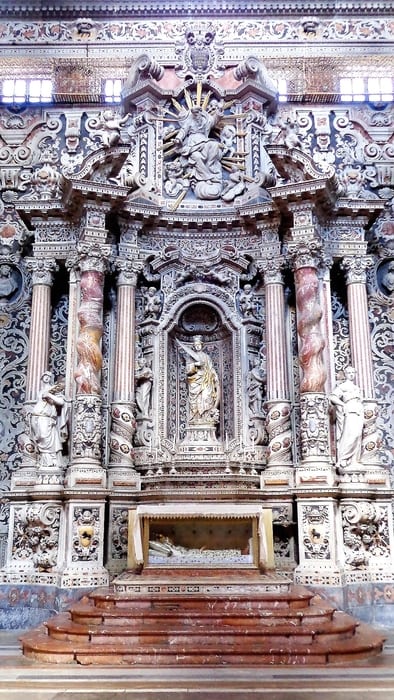
Several prominent architects and artists worked on the church back in the mid-1500s, including Antonello Gagini, Giacomo Amato, and Giovanni Battista Ragusa. Oil paintings and frescoes adorn the building, and it’s a beautiful place to visit in Palermo .
Walking through this church is like stepping into a massive treasure chest. You’ll see altars of amethyst and lapis lazuli, precious stucco statues, and floor-to-ceiling adornments. Some of the most famous works here include the frescoes Triumph of Saint Catherine in the vault and The Soul in Glory Rises to Heaven in the chancel.
19. Climb atop the dome at Church of Santissimo Salvatore
Climbing to the dome of the Church of Santissimo Salvatore is one of the best things to do in Palermo at night . From there, you can look over the city and see all the twinkling lights.
The Church of San Salvador is in Bellini Square, so it has the perfect central location. It was built in the 12th century when Norman architecture was at its prime. However, it wasn’t until just a few years ago that it received UNESCO World Heritage Site status.
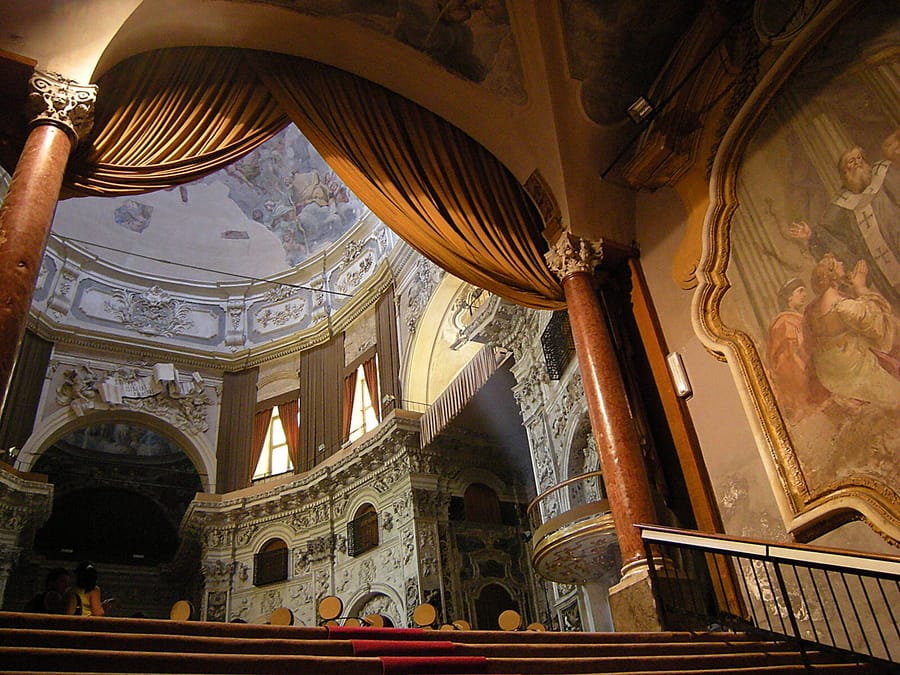
19. Climb atop the dome at Church of Santissimo Salvatore, the best thing to do in Palermo at night
The three red domes atop the church make it a familiar landmark for anyone visiting Palermo, Italy . It’s a smaller church, and while it seems quite simple, the interior boasts some impressive stonework. You’ll also find Byzantine-style mosaics and frescoes inside, along with more modern altars.
Seeing this monumental structure at night is a lovely sight, especially with the Fontana Pretoria in the background. Plus, this church is close to Quattro Canti and La Martorana, and on the way to the Norman Palace.
20. Visit the Old Harbor of La Cala, a great thing to do in Palermo with kids
Visiting La Cala , the oldest port in the city, is a good way to end your tour of Palermo . This arch-shaped harbor was once an inlet for the Kemonia and Papireto rivers, but now it’s a popular tourist spot along the water.
Today, anyone can take a stroll along the waterfront pier, but back in the day, the port was protected by an Arab fortress. Castello a Mare had various uses throughout history, including as a prison and a private residence.
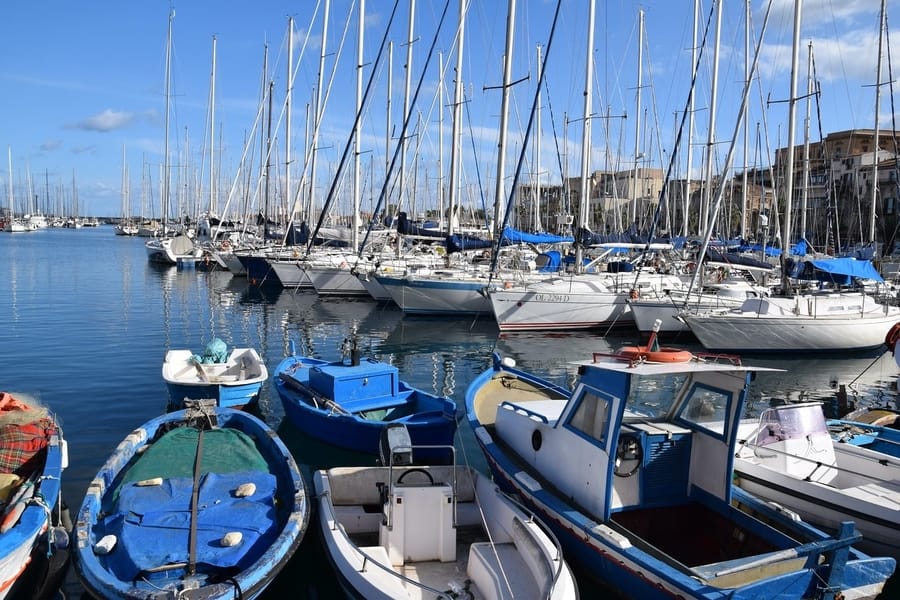
Recent urban development projects have contributed to La Cala’s expansion, so now it offers more stuff to do in Palermo . For example, next to the pier is the Piazza Marina , where you’ll find the Garibaldi Garden . The garden is famous for having the largest Australian banyan tree in Europe, and it’s a pleasant area to walk through.
While you’re there, check out the historic Kalsa neighborhood and some of the nearby Palermo attractions like Galletti Palace of San Cataldo, Notarbartolo Palace, and Chiaramonte-Steri Palace.
21 Walk through Palazzo Abatellis, something exciting to do in Palermo
The Abatellis Palace is an intriguing building in Palermo’s Kalsa neighborhood. Constructed in the 1400s, it’s a prime example of Gothic-Catalan architecture and served as the home of Francesco Abatellis, port master of the Kingdom of Sicily. He had no heirs, so after his death, the palace became a convent.
The building was destroyed during World War II but was later restored and used to store medieval art. Today, this Palermo attraction houses the Sicilian Gallery of Art.
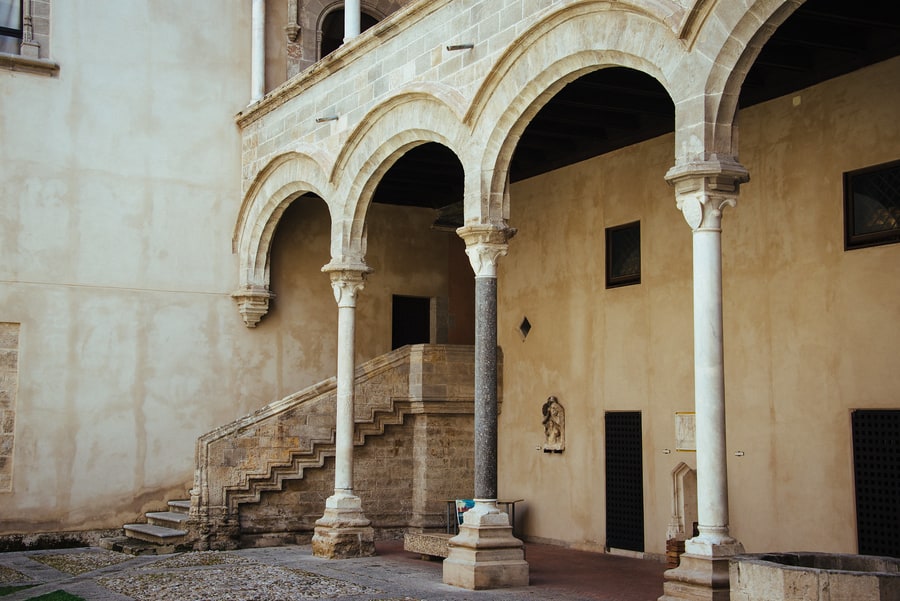
Over the years, the museum has amassed a noteworthy collection of art, religious works in particular. Here, you can find Virgin Annunciate , the famous Renaissance painting by Antonello da Messina, as well as The Triumph of Death fresco that was formerly in the Palazzo Sclafani.
If you’re interested in learning more about medieval art, or you’re wondering what to do in Palermo when it rains , this art gallery and palace is a good option.
22. Cefalú, one of the top places to go near Palermo, Sicily
If you are not going to rent a car in Sicily, there are still plenty of cool tours from Palermo you can take. I recommend this excursion to Cefalù , a beautiful fishing village overlooking the Tyrrhenian Sea and one of the best places to visit in Sicily .
In addition to Cefalù, this tour includes a visit to the impressive Cathedral of Monreale, one of the nicest places to visit near Palermo . Once in Cefalù, you’ll see the Mandralisca Museum , which contains archaeological artifacts, ancient coins, antiques, and the works of Antonello da Messina.
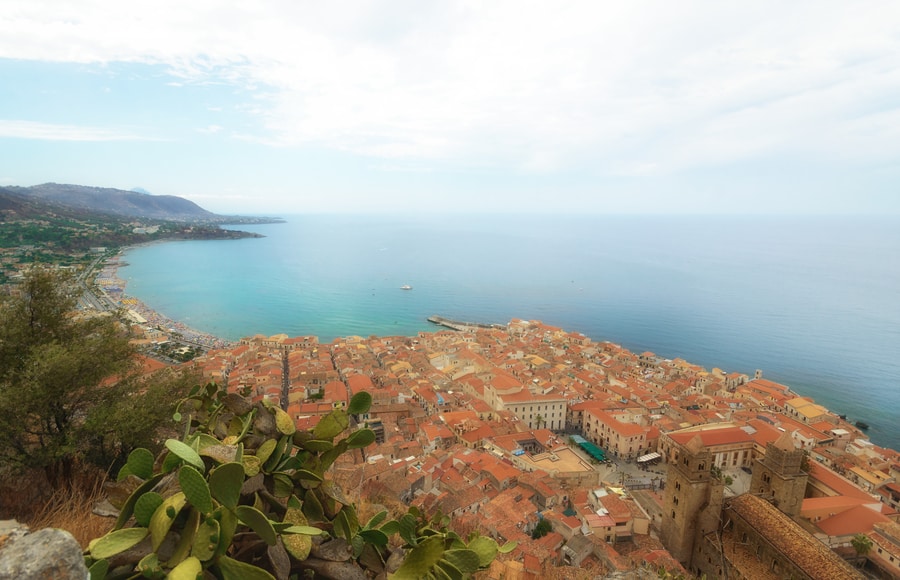
The tour continues with a visit to the Osterio Magno , a fortified palace built in the 13th century, as well as the 16th-century Lavatorio Medievale , an old washing room that was restored in the 1990s. Finally, you’ll see the Norman-style Cefalù Cathedral , a UNESCO World Heritage Site built in 1131. It’s known for its Byzantine mosaics, most notably the bust of Christ Pantokrator.
Not only does Cefalù make for a great Palermo day trip, but you’ll get incredible panoramic views of the sea.
23. Visit Segesta, Erice, & Trapani, one of the best day trips from Palermo
Combining a visit to Segesta, Erice, and Trapani is another awesome day trip from Palermo that you can take if you don’t want to drive around the island.
I recommend this full-day excursion that hits all three villages. You’ll start with Segesta , where you can explore some prominent Greek archaeological sites, including a well-preserved Doric temple that’s believed to date to around 420 BC.
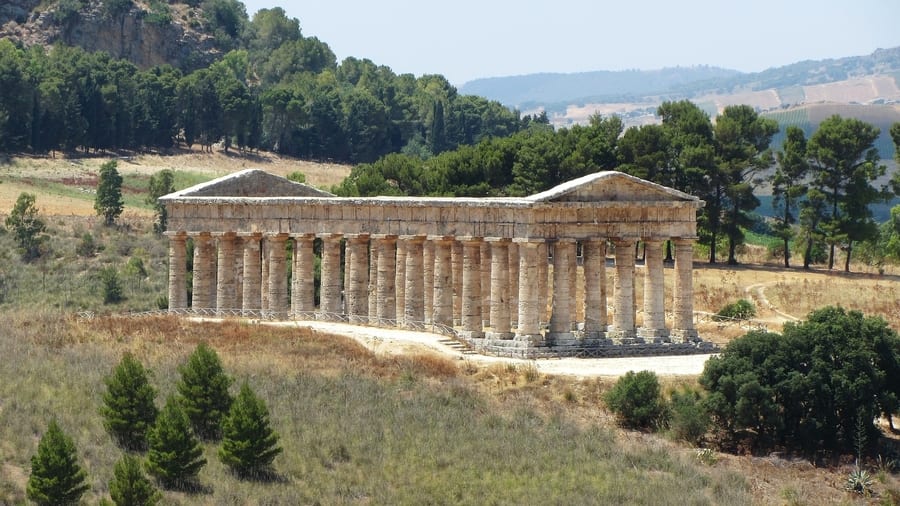
The tour continues to the Trapani salt flats , which line the coast. Trapani is home to several Baroque monuments, such as the Church of Saint Augustine, Ligny Tower, and the Triton Fountain.
Finally, you’ll stop by the town of Erice , which has medieval origins and boasts impressive hillside views. There are also historical sites like two ancient castles and the remains of Elymian and Phoenician walls.
If you’re looking for things to do in Palermo and its surroundings, this is a great tour. Plus, transportation is included, so you can relax and enjoy the sights.
24. Taormina & Mount Etna, one of the best tours in Palermo, Sicily
Fortunately, you don’t have to rent a car or drive to see the main tourist sites in Palermo . There are lots of daily tours that depart from this city and go to all the popular tourist attractions in Sicily .
Of the top things to see in Palermo , I would say that Taormina and Mount Etna are two of the most important. You can see them both in one day with this excursion.
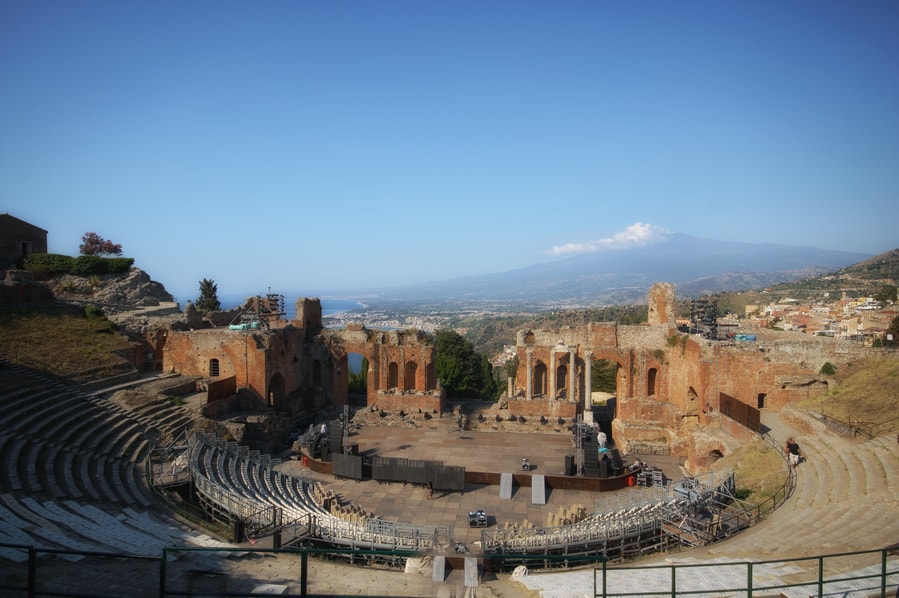
First, you’ll visit Mount Etna , the tallest active volcano in Europe. At over 10,800 feet high, it’s a prized place among hikers who come to Sicily. That said, this tour only ascends about 8,200 feet, but you’ll still get to see the Silvestri Craters and get amazing views.
The second half of the tour takes you to the city of Taormina , which sits on a cliff overlooking the Isola Bella Nature Reserve and the Ionian Sea. While you’re here, you’ll visit the ancient Greek theater, several Baroque churches, and enjoy the seaside view of the bay’s aquamarine waters.
25. Agrigento & the Valley of the Temples, another great tour from Palermo
My last recommended place to visit near Palermo is Agrigento and the Valley of the Temples . If you arrive in Palermo and you don’t want to drive, don’t worry because this full-day tour will take you to all the best sites.
The Sicilian city of Agrigento is famous for the Valley of the Temples, an extensive archaeological site. Here, you’ll find several Greek temples, most of which are in decent preserved condition.
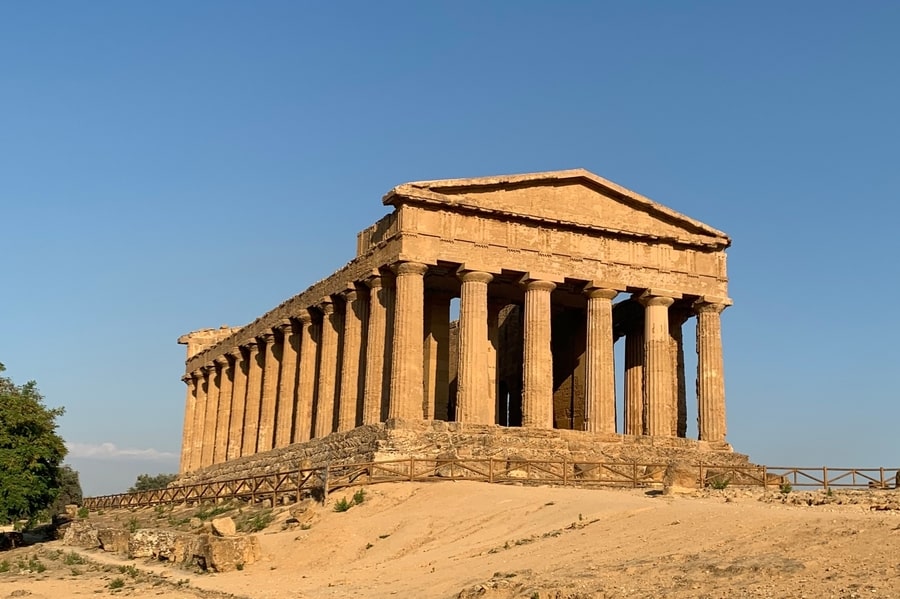
The Temple of Concordia is the best-preserved temple there and was built in the 5th century. The Temple of Castor and Pollux is a modern-day symbol of Agrigento, while the Temple of Asclepius was an ancient pilgrimage site for those seeking cures from illnesses.
The tour includes another must-see place near Palermo , the Archaeological Museum of Agrigento . Here, you can look through over 5,600 artifacts, including restored archaeological remains, coins, and inscriptions. Look for the interesting Atlantean statue out front that serves as a decorative column.
Without a doubt, visiting Agrigento is one of the top things to do around Palermo if you want to see some historical monuments and don’t feel like driving.
Where to stay in Palermo, Italy
During our visit to Palermo , we stayed in this apartment in the Capo neighborhood . The apartment was beautiful and well-priced, but I think next time, we’ll stay somewhere closer to the city center.
If you’re looking for a hotel in the downtown district of Palermo , I suggest staying in the Vucciria neighborhood . These are the best options:
- Mamamia Hostel & Guesthouse
- Eurostars Centrale Palace Hotel
- B&B Hotels – Hotel Palermo Quattro Canti
The Kalsa neighborhood is also a good option if you are looking for places to stay in Palermo near the port or bus station. These are the best options:
- B&B Palazzo Corvino
- Hotel Palazzo Sitano
However, if you want a room with a view in Palermo, this accommodation in the Albergheria neighborhood is the best option.
Any of these four Palermo neighborhoods will be an excellent option, as they’re close to the city’s main points of interest.
If any of the accommodations I mentioned are no longer available, you can look for other options here . Also, you can often find good deals on Airbnb. If you don’t have an account yet, you can get a $50 Airbnb coupon code here.
earn $50 Cash Reward at Airbnb
Where to eat in Palermo, Sicily
When we were in Palermo, we took advantage of some of the best local dishes and authentic Italian cuisine.
One of the best places to eat in Palermo is the Vucciria market , where you can enjoy all kinds of street food. Besides, you can sight-see while you eat, so it’s a must-do in Palermo .

Where to eat in Palermo
However, if you’re wondering where to go in Palermo to enjoy a pizza, I highly recommend Pizza Ferrari . From the outside, it looks like a typical neighborhood pizzeria, but it has some of the best pizza in Sicily. To complete your meal, grab a Peroni, the most popular Italian beer. You can check Pizza Ferrari’s hours, location, and menu on their Facebook page .
How to get to Palermo from the airport
Parking in downtown Palermo is quite an adventure, so I recommend taking public transportation to get to the city center, even if you plan to rent a car in Sicily.
If you’re not sure how to get to the center of Palermo from the airport , the best way is with the 29 bus . It departs from the airport and stops at Piazza Giulio, where you’ll find the central bus station.
Alternatively, you could take the Trenitalia train from the airport, which is just as fast as the bus. You could also take a taxi, but it’ll be much more expensive.
In short, I think it’s better to go downtown by bus or train and then return to the airport later to pick up your rental car. Believe it or not, you’ll save lots of time because you won’t spend hours trying to find a parking spot in Palermo’s city center.
Map of Palermo, Sicily (Italy)
Now that you know the top things to do in Palermo, Italy , here is a tourist map of Palermo . Download it and keep it handy as you plan your itinerary and your route around Palermo.
That’s everything I have for your visit to Palermo, Sicily ! Now you know what to visit in Palermo and the nearby areas. As you can see, you can visit Palermo’s main attractions in one or two days, and it’s an ideal starting point for your route through Sicily. If you have any questions, feel free to leave me a comment, and I’ll help as much as I can. I wish you safe travels and lots of fun!
Don't miss a 5% discount on your HeyMondo travel insurance
and the only one that pays all your medical bills upfront for you!
Ascen Aynat
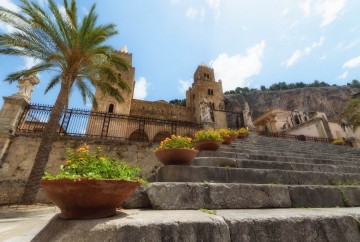
Leave a Reply Cancel reply
Your email address will not be published. Required fields are marked *
This site is protected by reCAPTCHA and the Google Privacy Policy and Terms of Service apply.


- Places and cities
- Attractions
- Map of museums and parks
- LIVING SICILY
- Itineraries
- Travel proposals
- How to reach Sicily
- Tourist information
Here we are in Sicily’s capital city, and you can already feel the authentic atmosphere that wins the hearts of everyone who sets foot there. Whether yours is a quick tour of the city’s historic centre , or a trip to slowly savour Palermo and its surroundings, we’ll make sure you don’t miss a thing.
Here are ten reasons why you’ll leave your heart in this city.
- A dip in the Baroque of Casa Professa
The Arab-Norman Palermo itinerary will certainly take us to places of extraordinary beauty. But a tour of Baroque Palermo will be just as surprising!
Palermo’s most symbolic Baroque building is probably the Chiesa del Gesù , better known as Casa Professa . It stands on a rise full of dark ravines where, according to tradition, hermit saints once took refuge and where early Christian catacombs can still be found. A violent bombing raid in 1943 destroyed a large part of the prestigious monument.
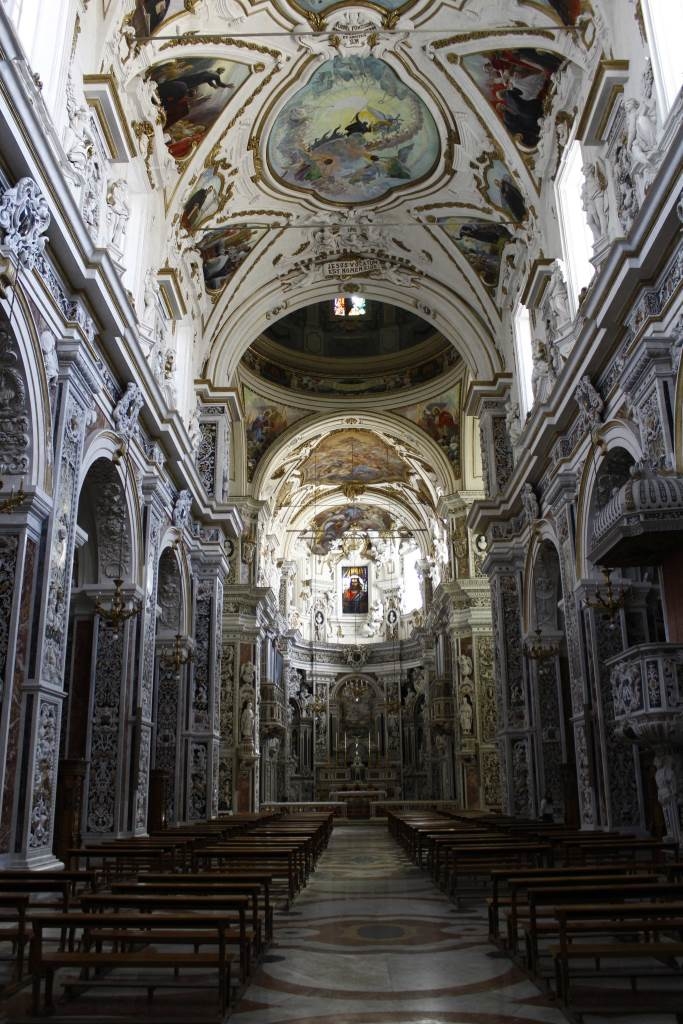
Chiesa di Casa Professa – ph. Mannarano
Restoration work has restored almost all the stucco and frescoes, restoring the church to its original appearance. The interior blends late Renaissance rigour with a new Baroque spatial style.
- Le stanze al Genio
The name Casa Museo Stanze al Genio refers to the nearby Fontana del Genio in Palermo, at Piazza Rivoluzione . Once through the large doorway, we are quickly drawn to the stairs by the rich flooring and original frescoes of the late 18th-century building. What will appear before us is a unique collection of more than 2300 Italian majolica tiles. They are the pieces of a huge artistic puzzle from southern Italy (mainly Campania and Sicily) from the late 16th to early 20th century. The collectors, owners of the building, will take us into a world where art takes on the dimensions of a small walkable square.
- The “theatrical” Piazza Vigliena: the Quattro Canti
The most scenic urban corner of Palermo is undoubtedly represented by the Quattro Canti , the point where Via Maqueda and Via Vittorio Emanuele intersect dividing the city into four historic districts (districts). Four buildings outline the profile of the suggestive seventeenth-century square, known as Piazza Vigliena , which every July 14 awaits the most significant stage of the exciting procession of Santa Rosalia . Four main elements stand out on each facade: a fountain which represents one of the rivers that once crossed the city; an allegory depicting one of the seasons; the statue of one of the Spanish kings and, on top, the statue of one of the patron saints of Palermo, each placed to protect a district. Throughout the year, at least one facade of the buildings is illuminated by the sun: this is why the Quattro Canti are called “Teatro del Sole” . The square, whose shape resembles an octagon with mussed edges, once housed public festivals and capital executions. This explains why it is also known as the “City Theater” .
- A premiere at the Teatro Massimo
But also a simple guided tour will do. The Massimo is Italy’s largest opera house, the third largest in Europe after the Paris Opera House and the Vienna State Opera,
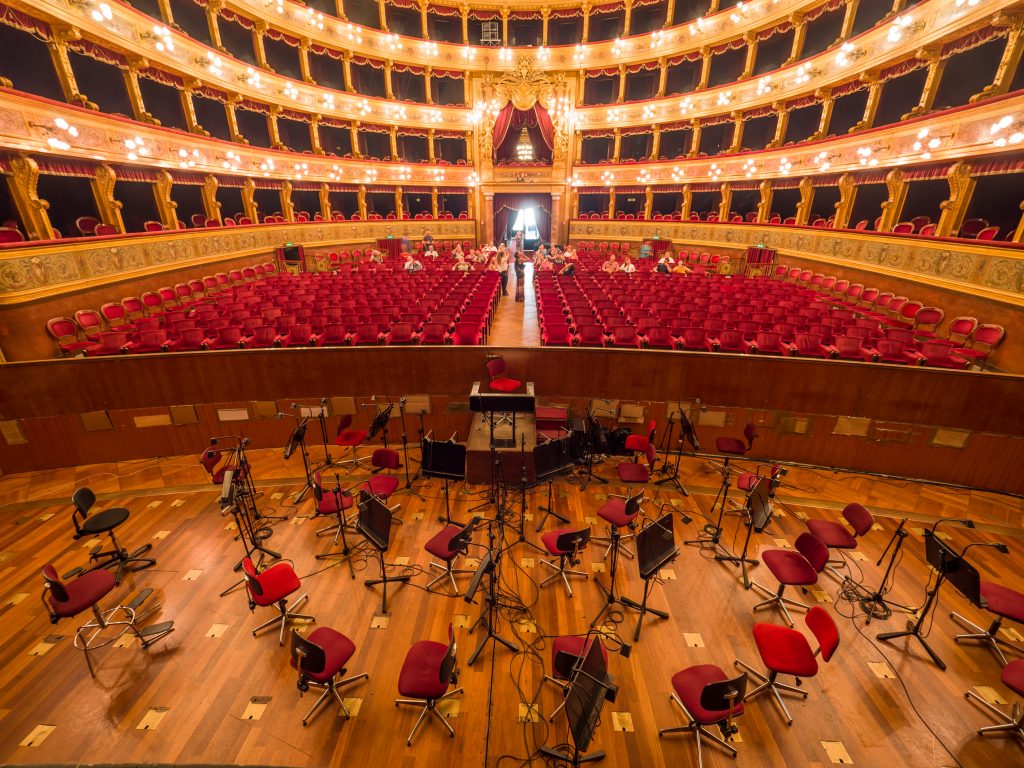
Teatro Massimo – ph. P. Barone
and a symbol of the grandeur of the Art Nouveau period, when Palermo was so beautiful and elegant that it attracted and hosted the most sought-after European courts. Today, you can plan a visit to the city and then attend an opera, ballet or symphonic music premiere , rediscovering the atmosphere of the glorious Florio days.
- UNESCO Heritage Opera dei Pupi
This is the first Italian UNESCO Heritage site to be included in the Intangible and Oral Heritage of Humanity list in 2008.
Throughout the island, you can watch performances of the Opera dei Pupi by talented puppet masters who have made this tradition a worldwide art icon. The theatre venues in Palermo, together with the Antonio Pasqualino International Puppet Museum , are a truly unique attraction.
Continue the tour on the Izi Travel audio guide .
- Catacombs of the Capuchins
A place you wouldn’t go if you were dead? Everyone says so, but then it’s impossible to resist the temptation to go and see them. The Capuchin Catacombs contain 8,000 mummified bodies: from Capuchins to members of noble families, from the bourgeoisie to representatives of the clergy.
The state of preservation of the countless corpses on display makes the cemetery of the Convent of the Capuchin Friars one of the most impressive places to visit in the world. A macabre spectacle that highlights the customs and traditions of Palermo’s city society during the period between the 17th and 19th centuries. It is also home to the world’s most beautiful mummy: little Rosalia.
Find out more about the Capuchin Catacombs on izi.TRAVEL
In the old Kalsa quarter, with a little imagination, we can smell an intense scent of basil wafting through the air. All thanks to one of Sicily’s most fascinating stories, which explains the birth of the artistic Teste di Moro – the famous Moorish Heads .
Perhaps that’s why it seems natural to us, to find near the Palazzo Abatellis , the Galleria Regionale della Sicilia , curated by the Cultural Heritage Department, at Palazzo Abatellis. The palace is a magnificent example of Gothic-Catalan architecture. Inside, the arrangement of the works is truly innovative: the use of metal or wooden supports on coloured backgrounds of fabric, Venetian stucco or wooden panels enhances the beauty of the paintings.
In the marvellous rooms of the historical building, we find important masterpieces by Domenico and Antonello Gagini, Filippo Paladini, Antonello da Messina and Francesco Laurana. There are also works by Pietro Novelli, Antoon Van Dyck and Vito D’Anna. The Annunciata by Antonello da Messina alone is worth a visit.
Another beautiful aristocratic residence full of history in the Kalsa is Palazzo Mirto : Murano chandeliers, Chinese lacquered panels, clocks, tapestries and porcelain. The sumptuous, regal rooms embrace a terrace decorated with a rocaille fountain.
Villa Garibaldi , in Piazza Marina , is removed from the hustle and bustle and has plenty of shady spots in which to shelter from the hot sun. It was built between 1861 and 1864 by architect Giovan Battista Filippo Basile and dedicated to hero Giuseppe Garibaldi to celebrate the birth of the Italian nation. Many exotic plants can be found here, including the majestic Ficus macrophylla subsp. Columnaris or Ficus magnolioide , a tree that is native to the tropical rain forests. With its 10,000 cubic metres of foliage, it is the largest tree in Europe. That is why it is always admired by people from all over the world.
In the evening, Piazza Marina is transformed: eateries in which to sample typical dishes and local wines, pubs for an apéritif, with live music and popular songs, street food of all kinds. On Sunday mornings, there is a colourful and characteristic antiques market, full of objects, vintage clothes, books and much more at reasonable prices.
For the romantics, a carriage tour is just as exciting, from which you can enjoy the beauty of the old town.
- Street food and ancient markets
The ranking, drawn up by the American network Virtual Tourist, places Palermo in 5th place among the best producers of street food in the world. The street food tour is a must along with the tours of the ancient markets of Palermo, Vucciria , Ballarò , il Capo and Borgo Vecchio, nowadays animated by the city’s nightlife, which has elected them as favourite chosen them as meeting places for leisure evenings.
Let’s discover them in a morning or with a tour by night: it will be like crossing millennia of history, art, scents, flavours and the atmospheres of diverse civilisations.
In the tangle of alleyways, you can discover a multitude of sensations: among the stalls full of colourful merchandise, the Palermitans often eat food cooked in the streets, nibbling with their hands.
Panelle e cazzilli , pane con la milza , sfinciuni , stigghiole , polpo bollito, are just a few of the specialities that have made Palermo one of the world capitals street food .
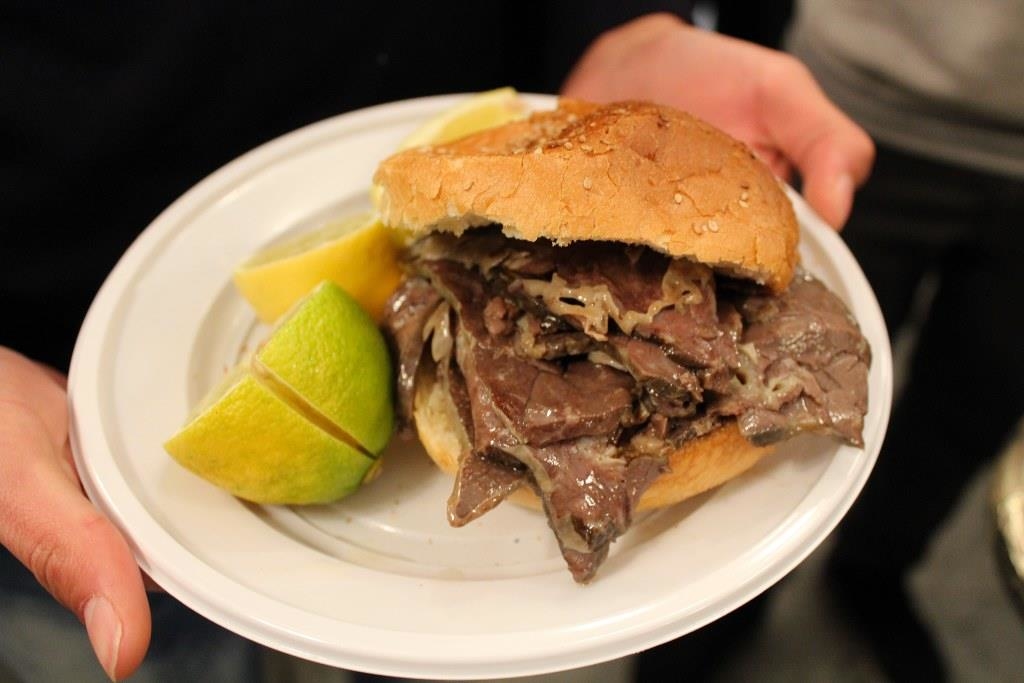
Pane con milza – ph. I. Mannarano
Flavour and tradition distinguish the Sanlorenzo Market ; it’s worth a visit in its own right. It is located in an old citrus factory dating back to the 1940s, which has been restored by combining the original structure with modern design elements, with a special focus on reuse art. There are various culinary specialities in nine shops and a selection of around 2,800 products from 250 Sicilian suppliers.
You can shop for food or eat dishes prepared according to traditional local recipes. This is a true indoor market that brings together some of the most interesting selected food and wine products: from Slow Food presidia to all the other products that give rise to Sicily’s extraordinary biodiversity, with its 29 PDO and PGI products and 41 Presidia.
- A stroll in Mondello
Mondello’s beach is one of the most beautiful in Sicily , from spring to autumn, it offers safe bathing also for the less able to swim and for children. The white sand is a palette for the sea, the sun and the clouds that paint an infinite range of colours, from turquoise to emerald green. Colours that remain impressed in your memory.
The promenade along the seafront, under tall maritime pines, between palm trees and sporadic houses in the Art Nouveau style, will allow us to put our thoughts in order, to chat, to indulge in jogging or simply breathe in the beneficial scent of the sea, rich in iodine.
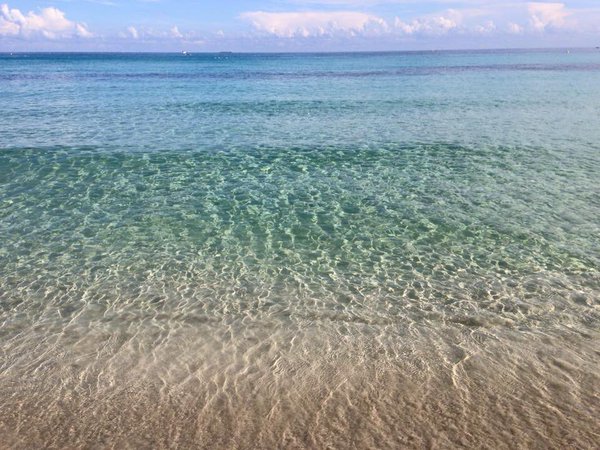
Mondello beach Palermo – ph robianni
The seaside village, “la piazza”, awaits us with its cafés and restaurants by the sea, or takeaways, to indulge in seafood and ready-to-eat sandwiches. The bathing season runs from May to September, when the beach is equipped with deckchairs and umbrellas and the characteristic multicoloured wooden cabins. Mondello abandons its solitary, reflective winter appearance and fills with carefree voices, sunscreen and young people on mopeds. The change of season is marked by the World Festival On The Beach , the famous international water activities exhibition, which usually takes place between May and June.
- Palermo and surroundings
If you have the chance, don’t forget to visit the surrounding area: Borgo Parrini a Partinico , Terrasini e Cinisi , The Museo dell’Acciuga ad Aspra and the famous historic Villas of Bagheria , Caccamo , Monreale and its Cathedral.
We can move around by motorbike or bicycle, visit the singularly picturesque hamlets on the Madonie Mountains , some of Italy’s most beautiful: Castelbuono , Cefalù , Geraci Siculo , Petralia Soprana .
Condividi questo contenuto!
DEPARTMENT OF TOURISM, SPORT AND ENTERTAINMENT – SICILY
Via Notarbartolo, 9 – 90141 – Palermo
Tourist Informations
This website is not for profit, anyone who sees a possible infringement of copyright can report it and we will promptly remove the specific content.
VISIT SICILY
ACCESSIBILITY
- Toggle High Contrast
- Toggle Font size
© 2022 Regione Siciliana – All rights reserved
VAT number: 02711070827 – Tax Code: 80012000826 – Privacy
DATA PROCESSING
Privacy preview.
Must-see attractions in Palermo

Cappella Palatina
Designed by Roger II in 1130, this extraordinary chapel is Palermo's top tourist attraction. Located on the middle level of Palazzo dei Normanni's three…
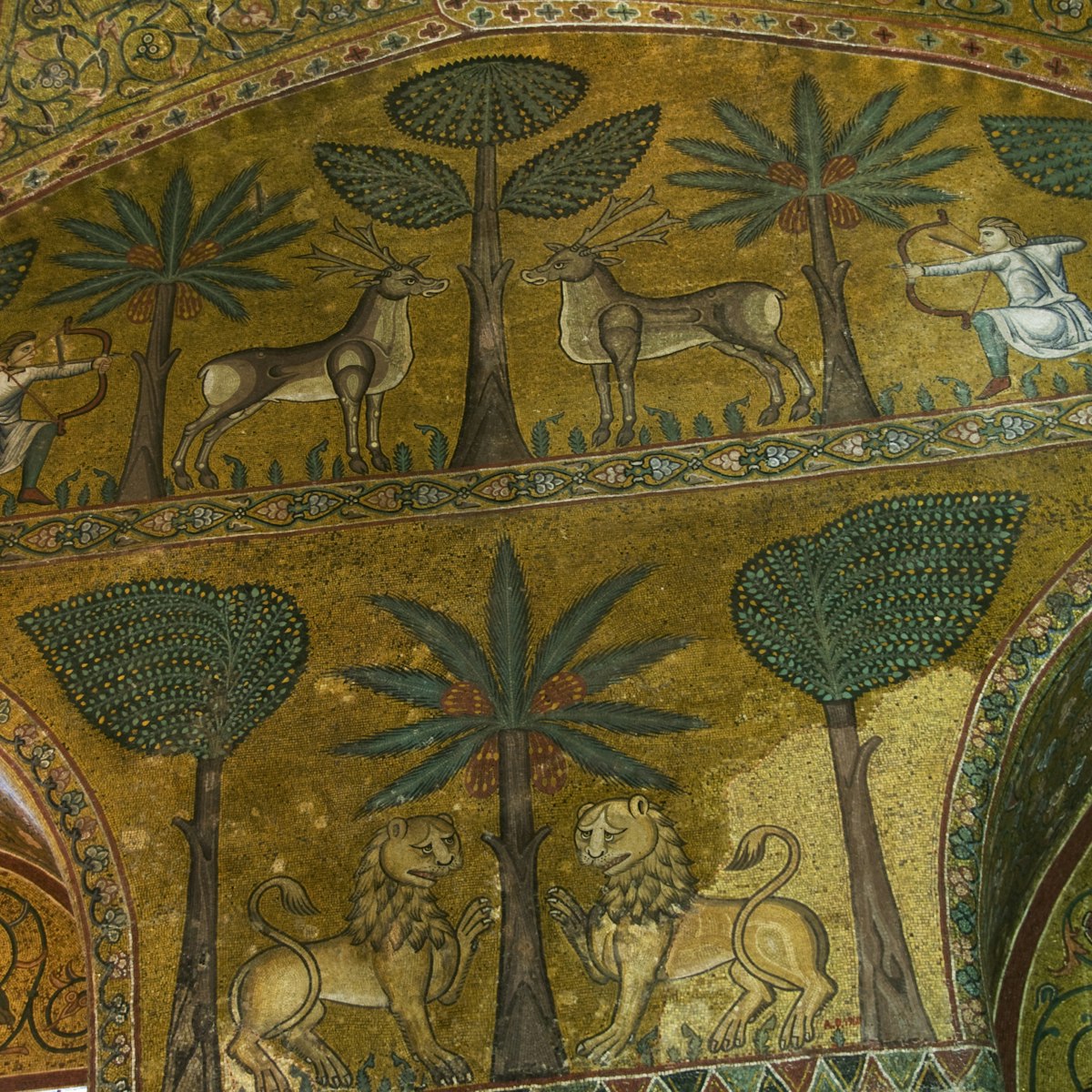
Palazzo dei Normanni
Home to Sicily's regional parliament, this venerable palace dates back to the 9th century. However, it owes its current look (and name) to a major Norman…
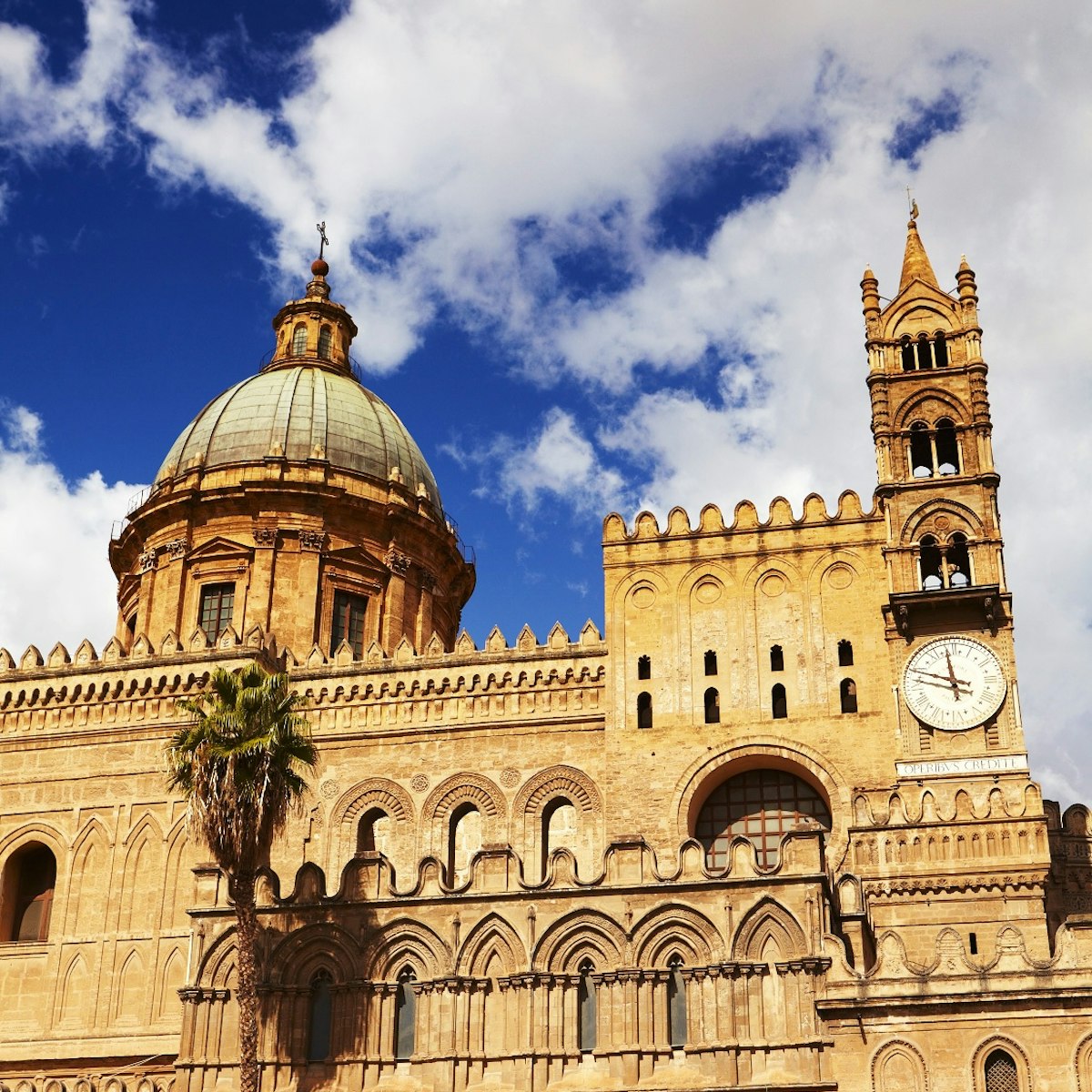
Cattedrale di Palermo
A feast of geometric patterns, ziggurat crenellations, maiolica cupolas and blind arches, Palermo's cathedral has suffered aesthetically from multiple…
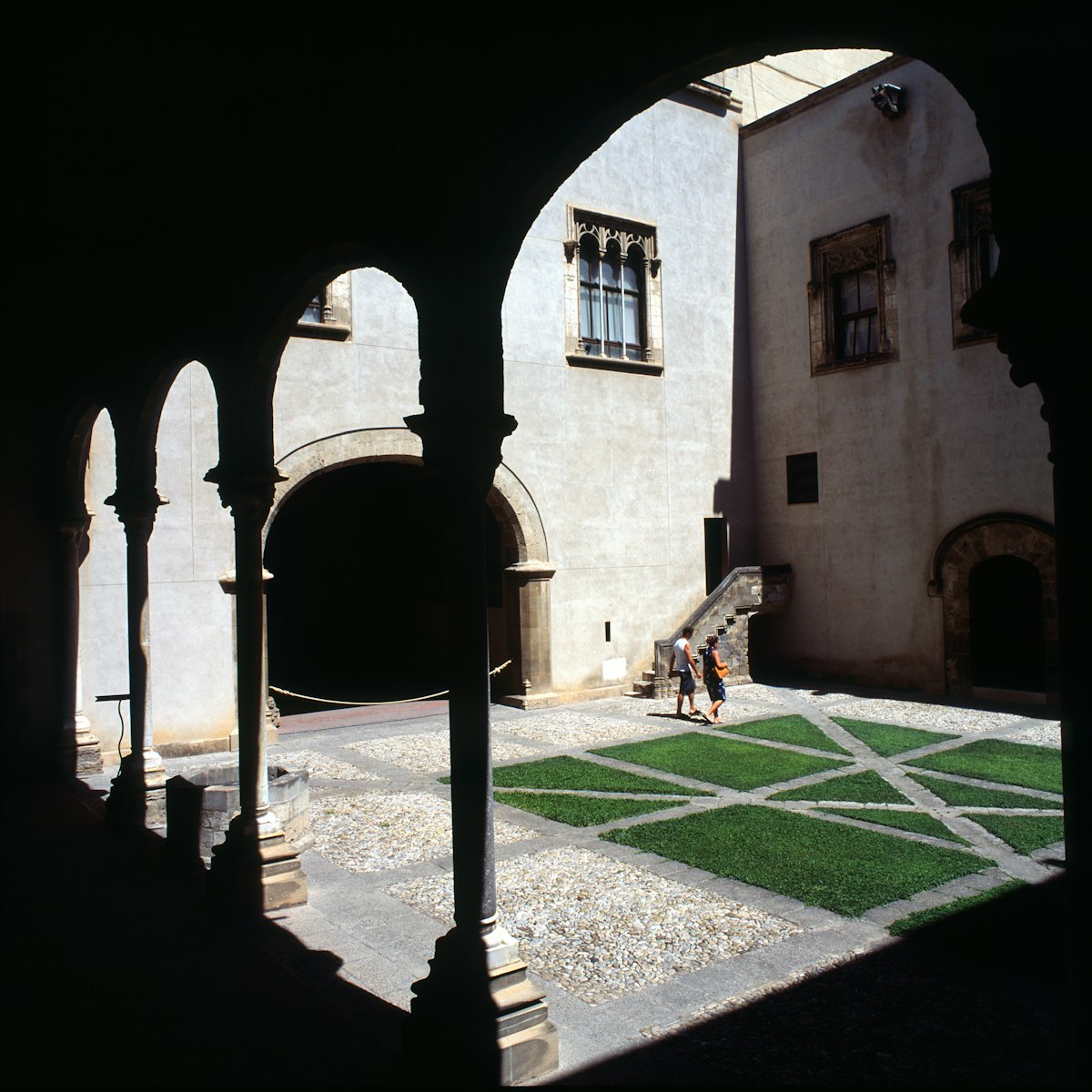
Galleria Regionale della Sicilia
Housed in the stately 15th-century Palazzo Abatellis, this art museum – widely regarded as Palermo's best – showcases works by Sicilian artists dating…

Chiesa e Monastero di Santa Caterina d'Alessandria
Built as a hospice in the early 14th century and transformed into a Dominican convent the following century, this monastic complex wows with its…

Teatro Massimo
Taking over 20 years to complete, Palermo's neoclassical opera house is the largest in Italy and the second-largest in Europe. The closing scene of The…

Mercato di Ballarò
Snaking for several city blocks southeast of Palazzo dei Normanni is Palermo's busiest street market, which throbs with activity well into the early…
Palazzina Cinese & Parco della Favorita
Once a retreat for King Ferdinand IV and his wife Maria Carolina, this pagoda-inspired pavilion exemplifies the popularity of 'Oriental exotica' in 18th…
Pinacoteca Villa Zito
Elegant 18th-century Villa Zito houses a sharply curated collection of mainly Sicilian-themed art spanning the 17th to 20th centuries. You'll find a…

La Martorana
On the southern side of Piazza Bellini, this luminously beautiful 12th-century church was endowed by King Roger's Syrian emir, George of Antioch, and was…

Museo Archeologico Regionale Antonio Salinas
Situated in a Renaissance monastery, this splendid, wheelchair-accessible museum houses some of Sicily's most valuable Greek and Roman artefacts,…
Museo dell'Inquisizione
Housed in the lower floors and basements of 14th-century Palazzo Chiaromonte Steri, this fascinating museum explores the legacy of the Inquisition in…
Oratorio di Santa Cita
This 17th-century chapel showcases the breathtaking stuccowork of Giacomo Serpotta, who famously introduced rococo to Sicilian churches. Note the…
Oratorio di San Lorenzo
The late-16th-century Oratory of St Lawrence features glorious stuccowork by master rococo sculptor Giacomo Serpotta. Capturing scenes from the lives of…
Chiesa di San Giuseppe dei Teatini
In the southwestern corner of the Quattro Canti is this 17th-century church, topped by an elegant cupola designed by Giuseppe Mariani and flanked by the…
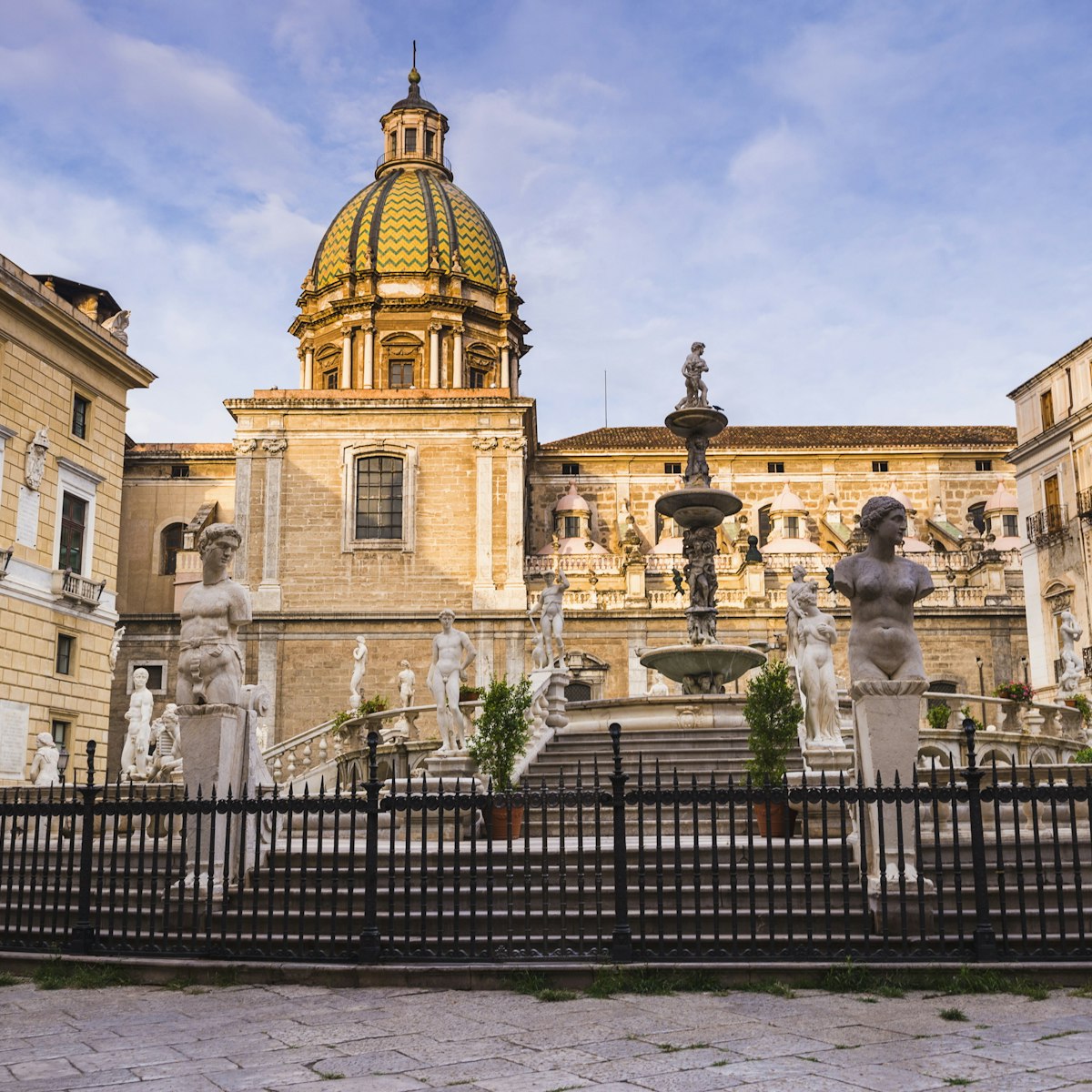
Fontana Pretoria
Fringed by imposing churches and buildings, Piazza Pretoria is dominated by the over-the-top Fontana Pretoria, one of Palermo's major landmarks. The…

Orto Botanico
Laid out by Léon Dufourny and Venanzio Marvuglia, this raffish, subtropical paradise shelters massive fig trees, tall palms and dazzling hibiscus bushes,…
![palermo italy tourist attractions [UNVERIFIED CONTENT] If you go to Sicily you can't miss the capuchin catacombs of Palermo, something that confirms the ghoulish side of this city. A cemetery that contains 8000 mummies, lined upon walls, lying or standing, skeletons, and perfectly preserved bodies. It was active until 1920, when the last body was interred.](https://lp-cms-production.imgix.net/2019-06/GettyImages-159818983_master.jpg?fit=crop&ar=1%3A1&w=1200&auto=format&q=75)
Catacombe dei Cappuccini
These catacombs house the mummified bodies and skeletons of some 8000 Palermitans who died between the 17th and 19th centuries. Earthly power, gender,…
Quattro Canti
Officially titled Piazza Vigliena, the elegant intersection of Corso Vittorio Emanuele and Via Maqueda is better known as the Quattro Canti. Marking the…
Galleria d'Arte Moderna
This lovely, wheelchair-accessible museum is housed in a 15th-century palazzo, which metamorphosed into a convent in the 17th century. Divided over three…
Chiesa di San Domenico
The current Chiesa di San Domenico was built in 1640 following the design of architect Andrea Cirrincione; the facade was added in 1726 after the…
Museo Diocesano di Palermo
Palermo's Diocesan Museum is home to an important collection of artworks. The basement hosts a medley of sculptures from the 15th to 18th centuries,…
Palazzo Mirto
Just off Piazza Marina, this palazzo is one of the few in Palermo open to the public. Dating back to the 17th century, the building served as the Palermo…
Museo Internazionale delle Marionette
This whimsical museum houses around 4000 marionettes, puppets, glove puppets and shadow figures from Sicily and Naples, as well as from further-flung…
Palazzo Branciforte
One of Palermo's grandest aristocratic palaces is now an impressive, multi-faceted cultural centre. One-hour guided tours (email ahead for English…
Villa Malfitano
A showcase of Liberty architecture, set in a 9-hectare (22-acre) formal garden planted with rare and exotic species, this villa is most notable for its…
Chiesa del Gesù
Also known as Casa Professa, this is one of Palermo's most breathtaking churches. The Jesuits first built a church on this site between 1564 and 1578…
Piazza Bellini
The disparate architectural styles and eras of the buildings adorning this magnificent piazza should by rights be visually discordant, but in fact…
Oratorio dei Bianchi
The 16th-century 'Oratory of the Whites' obtained its nickname from the white ceremonial gowns worn by its religious guild, whose members comforted…
Chiesa Capitolare di San Cataldo
This 12th-century church in Arab-Norman style is one of Palermo's most striking buildings. With its dusky-pink bijou domes, solid square shape, blind…
Pangrel Murals
What was once a row of dull apartment blocks is now a veritable open-air gallery, its trio of outstanding murals part of the Pangrel urban-renewal…
Chiesa di Sant'Agostino
The centrepiece of the Capo quarter is the Chiesa di Sant'Agostino and its adjoining Augustinian monastery, which ran the region in medieval times. A…
Chiesa di San Francesco d'Assisi
On a picture-perfect piazza, the much-amended Chiesa di San Francesco d'Assisi dates back to the 13th century. Remnants from its early history include the…
Oratorio di San Domenico
Dominating this small chapel is Anthony Van Dyck's fantastic blue-and-red altarpiece, The Virgin of the Rosary with St Dominic and the Patronesses of…
Museo delle Maioliche
Lovers of hand-painted Italian maiolica should make a beeline for this unique museum, which contains a superlative private collection of almost 6000 tiles…
Chiesa di San Giovanni degli Eremiti
One of Palermo's finest examples of Arab-Norman architecture, this five-domed, 12th-century church is named for Sicilian hermit-monk and miraculous wolf…
Museo Regionale d'Arte Moderna e Contemporanea della Sicilia (Riso)
In a restored 18th-century neoclassical palazzo, this two-level bastion of modern and contemporary art includes an extraordinary installation by Greek…
Chiesa di Santa Maria di Valverde
In 1633 this 14th-century Carmelite church underwent a lavish transformation designed by architect Mariano Smiriglio and driven by wealthy Genovese…
Falcone & Borsellino Mural
Sicilian street artists Rosk e Loste (Maurizio Giulio ‘Rosk’ Gebbia and Mirko ‘Loste’ Cavalletto) executed this striking mural of Sicilian anti-mafia…
Mercato del Capo
Running the length of Via Sant'Agostino, Capo's street market is a seething mass of colourful activity during the day, with vendors peddling fruit,…
Best Beaches
Things to Do Near Mt. Etna
Guide to Valley of the Temples
Food to Try
Best Wineries
Best Time to Visit
Weather & Climate
Things to Do in Sicily
Things to Do in Palermo
The Top 16 Things to Do in Palermo
:max_bytes(150000):strip_icc():format(webp)/ElizabethHeath-Headshot-horiz-e7525e97616245958bf3d94e8db7f119.png)
Ancient and edgy, the Sicilian capital of Palermo is a city of many contradictions. From venerable Arab-Norman architecture to a hip international food scene, elegant Baroque palaces and modern Liberty-style villas, pulsating outdoor markets, sun-soaked sandy beaches, the vibrant and always buzzing port city of Palermo is never lacking in things to do and see.
Compact and densely populated Palermo is fairly easy to explore on foot. Its historic city center can be divided east to west with cathedrals, museums, shopping, dining, and theatres all within walking distance of one another.
Here are our picks of the best 16 things to do in Palermo.
Start Your Day with Granita con Brioche
A visit to Palermo wouldn’t be complete without partaking in its most famous morning fare: a “breakfast” of a granita con brioche . The high-calorie delicacy—a sorbet-like frozen mixture of water and sugar flavored with fruit, nuts, chocolate, or coffee is paired with a warm and buttery pastry bun. The combo is most popular in the summertime, but you can order it all year round. To eat this treat like a local, break off a piece of brioche and dip it into the granita before taking a toothsome bite!
Be Inspired at the Palermo Cathedral
Sprawled across a grand piazza, Palermo’s Cathedral (Cattedrale di Palermo) is a UNESCO World Heritage Site. A wonder of Arab-Norman architecture, the centuries-old cathedral dedicated to Our Lady of Assumption has been modified several times over its 1500-year history. Today, it's a fascinating mix of geometric exteriors juxtaposed with neoclassical interiors, a reminder that this Catholic church was once a mosque. Vestiges of its dynamic past are everywhere: Norman arches, a medieval bell tower, a Catalan Gothic portico, and a cupola that harkens back to the Baroque age. Down below in the crypt, the oldest part of the church, you can visit the imperial tombs holding the remains of the church’s founders and wealthy patrons.
See Puppet Show at the Museo delle Marionnette
One of Sicily’s most enduring folk traditions, l’opera dei pupi (puppet theater) was designated a UNESCO Intangible Cultural Heritage in 2008. Learn about this beloved Sicilian art form at the Museo Internazionale delle Marionette Antonio Pasqualino. View an impressive collection of handcrafted puppets and marionettes ( burattini ), then delight in performances of Frankish romantic poems with main characters such as Charlemagne and his paladins battle to save the empire. The museum hosts the annual Festival di Morgana, which showcases traditional and contemporary puppetry worldwide.
Check Out Street Art in La Kalsa
Alternative Tours Palermo
The hip La Kalsa district is experiencing an urban renewal, and it's become a mecca for some of the most jaw-dropping street art in all the city. Spend some time strolling the colorful and gritty streets and alleyways and discover the range of works here, from tiny stenciled images to large graffiti masterpieces by renowned international street artists. Begin at the Mercato di Vucciria and check out the avant-garde murals by Ema Jons. Slowly wind your way through the quarter to end at the Pier of Sant’Erasmo, where you’ll be treated to a stunning view of the humungous mural depicting the saint for which the area was named. Alternative Tours Palermo offers a guided walking circuit of the uniquely Palermitan art scene.
Visit the Norman Palace
A masterpiece of Islamic architecture, the Norman Palace ( Palazzo dei Normanni ) was built by the Arabs in the 11th century and expanded by a Norman King as his royal palace. It’s been altered many times, the last in the 16th and 17th centuries. Today it is also home to the Sicilian Regional Assembly, with the royal apartments housing Sicily’s parliament.
Devote at least part of the day exploring this bastion of the city. With its elaborately adorned walls and arches, the Sala di Re Ruggero boasts beautiful 12th-century mosaics in motifs of plants and animals. The Chinese room has frescoes by Giovanni and Salvatore Paricolo, and Sala Gialla is marked by decorative tempera paintings on its vaults.
Following the tour, cool off in the shady public gardens located just outside the palace walls.
Experience the Palatine Chapel
A highlight of any visit to the Norman Palace is to behold the Palatine Chapel’s ( Cappella Palatina ) astounding mosaics. They’re a must-see for anyone visiting Palermo. Located on the second floor of the palace, the enchanting chapel, commissioned by Roger II (the first King of Sicily), is studded wall-to-wall with intricate mosaics depicting stories from the Bible and likenesses of prophets, saints, and warriors. Inside the center apse is a remarkable portrait of Christ flanked by angels and archangels. The chapel once had 50 windows to ensure the illustrated biblical stories were always illuminated.
Attend an Opera at Teatro Massimo
One of the foremost European opera houses and the largest in Italy, Teatro Massimo opened its doors in the late 1800s, during what was called the city’s belle epoque era—a cultural and social Renaissance of sorts. Lavishly decorated with Corinthian columns and ceiling frescoes, the Teatro is open year-round and includes opera, ballet, and music performances.
Plot a Course for Quattro Canti
Considered the crossroads of the historical center, the Quattro Canti (four corners) on Piazza Vigliena is a Baroque square marked by fountains and statutes on each corner. The concave facades, containing figures of Spanish kings and the four seasons, divide the city into four districts or mandamenti : Capo to the northwest, Loggia in the northeast, La Kalsa to the southeast, and Albergheria to the southwest. Constructed in the 1600s as part of Palermo’s new town plan, the fashionable square offers luxury shopping, hotels, and dining in the city's heart.
Scarf Street Food at Ballarò Market
Work your way over to Palermo's oldest and most vivacious open-air market, Mercato di Ballarò . There you can munch on mouth-watering street food. Choose your indulgences from the many street food vendors who set up stalls daily at this rollicking bazaar. For the best snacks on the go, grab a cone of paper filled with arancini ; deep-fried rice balls stuffed with ragu and cheese. If you're feeling more adventurous, try a pani câ meusa— a sandwich of chopped veal spleen simmered in lard. Wash it down with Sicilian craft beer and finish things off with a palate-cleansing gelato.
Count Mosaics at Monreale Cathedral
A spectacle of wealth and power, Monreale Cathedral ( Duomo di Monreale ) is an hour’s bus ride from the city center. Founded by King William II in 1172, the cathedral is famous for its twin-tower facade and 12th and 13th-century mosaics. Crafted by Sicilian and Byzantine artists, they form an enormous portrait of Christ the Pantocrator, as well as narrate scenes from the Old and New Testaments. In all, Monreale contains around 70,000 square feet of dazzling micro-tiles.
Don’t forget to visit the cloisters in the monastery at the south end of the cathedral. The Moorish-Norman stylized gardens are enlaced with hundreds of carved columns gilded with thousands of glistening tiles. A palm tree fountain plays a trickling soundtrack.
Be Captivated in the Capuchin Catacombs
Visit mummified bodies and skeletons of Capuchin friars, along with the remains of some of Palermo’s former aristocratic citizens at the Catacombe dei Cappuccini . Located west of the city center, this labyrinth of corridors is filled with well-preserved corpses, including the first friar to be interred there, Fra’ Silvestro dal Gubbio, who died in 1599. Visit a small chapel where the body of a little girl who passed in 1920 is so chillingly lifelike that she seems to be sleeping. The noted Sicilian writer Giuseppe Tomassi di Lampedusa ( The Leopard ) is buried in a tomb located in the cemetery next to the catacombs. Some find Italy's catacomb experiences creepy, while others find them strangely captivating. Regardless, they're not recommended for children under 12.
Climb to the Top of San Nicolo all'Albergheria Tower
Not far from the clattering noise of the Mercato di Ballarò, get a bird’s-eye view of Palermo’s city skyline by climbing the quadrangular tower of San Nicolo all'Albergheria (Torre di San Nicolo all'Albergheria). Dating back to medieval times, the austere and slender structure once served as a civic watchtower in defense of the fortified walls of the ancient Cassaro—the most ancient street in Palermo. From the terrace high above, catch a rare 360-degree glimpse of Palermo’s characteristic rooftops, glistening church domes, and impressive spires.
Catch Some Rays at Mondello Beach
A short distance north of the center of town (about a 30-minute bus ride), Mondello is a favorite summertime haunt for locals and tourists alike. The wide and white sand beach, pinched between two rocky promontories, is where you’ll find a small fishing port (once a 15th-century village) and rows of dining and bathing establishments ( stabilimenti ). Swim at the feet of Mount Pellegrino and Mount Gallo, then sun yourself all afternoon, either by renting a lounger and umbrella at a private club or by claiming a small plot of sand on the public side for free.
Eat a Cannolo
“Leave the gun, take the cannoli.” That classic line from the movie "The Godfather" serves to illustrate the reverence Sicilians have for their sugary, ricotta-filled pastry. Cannoli are made of deep-fried and crispy pastry shell tubes stuffed with sweetened creamy ricotta cheese, often mixed with fruit or nuts. Find Palermo’s best at Cannolissimo on the city’s main drag, Via Vittorio Emanuele. This charming pasticceria (pastry shop) often has lines out the door until midnight, so don't go there if you're in a rush.
Wander Vucciria Market After Dark
Immortalized by Sicilian artist Renato Guttuso in his famous "La Vucciria," this ancient outdoor market has a distinctive international flair. Located in Palermo’s Castellammare district, the market begins at Piazza San Domenico and runs south along Via dei Maccheronai to finish at Piazza Caracciolo. Although in decline since its heyday, it’s still a great place to buy fresh produce and fish, along with exotic spices, second-hand books, and antique bric-a-brac. But it’s when the sun goes down that Vuccuria Market lights up. Tables and chairs fill Piazza Caracciolo as young and old gear up for late-night music and dancing in the streets. To view Guttuso’s evocative painting in person, head to Palazzo Chiaramonte-Steri on Piazza Marina in the Kalsa quarter.
Shop for Mafia-Free Souvenirs
Addiopizzo.org
A growing anti-mafia movement is helping local businesses resist paying pizzo (extortion money) to the mafia. Support this grassroots effort by patronizing shops displaying the “ Addio pizzo ” (goodbye pizzo) sticker in the windows. Purchasing olive oil, wine, honey, mozzarella, and pasta with the words “ Libera Terra ” on the label is another way to support Sicily in its struggle against organized crime. Libera terra products are those grown on state-confiscated farmlands that are now free from mafia control.
The Top 15 Things to Do in Sicily
Trips to Sicily: The Complete Guide
Sicily's Valley of the Temples: The Complete Guide
The 10 Best Wineries in Sicily
12 Foods to Try in Sicily
Guide to Visiting Agrigento, Sicily
How to Get to Sicily
Weather in Sicily: Climate, Seasons, and Average Monthly Temperature
Taormina Sicily Travel Guide and Information
The Best Time to Visit Sicily
Ragusa, Sicily Travel Guide
Top 10 Things to Do in Procida
Sicilian Sights - Mt. Etna Volcano and Messina
Where to Go on Italy's Mediterranean Coast
The 5 Best Beaches in Sicily
The Top 9 Things to Do on Spaccanapoli, Naples

IMAGES
VIDEO